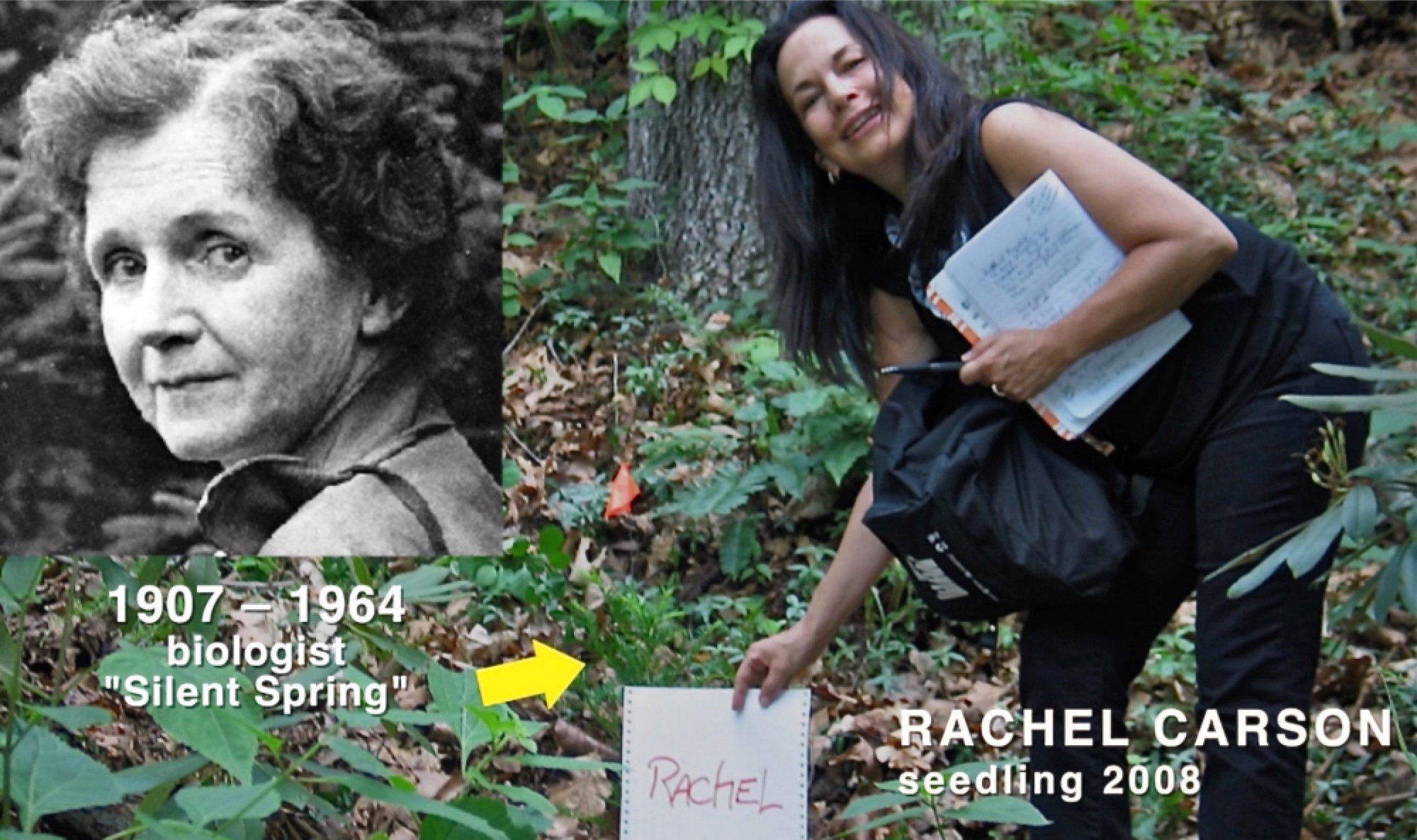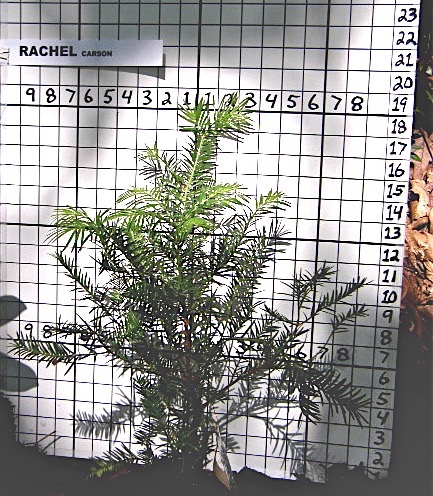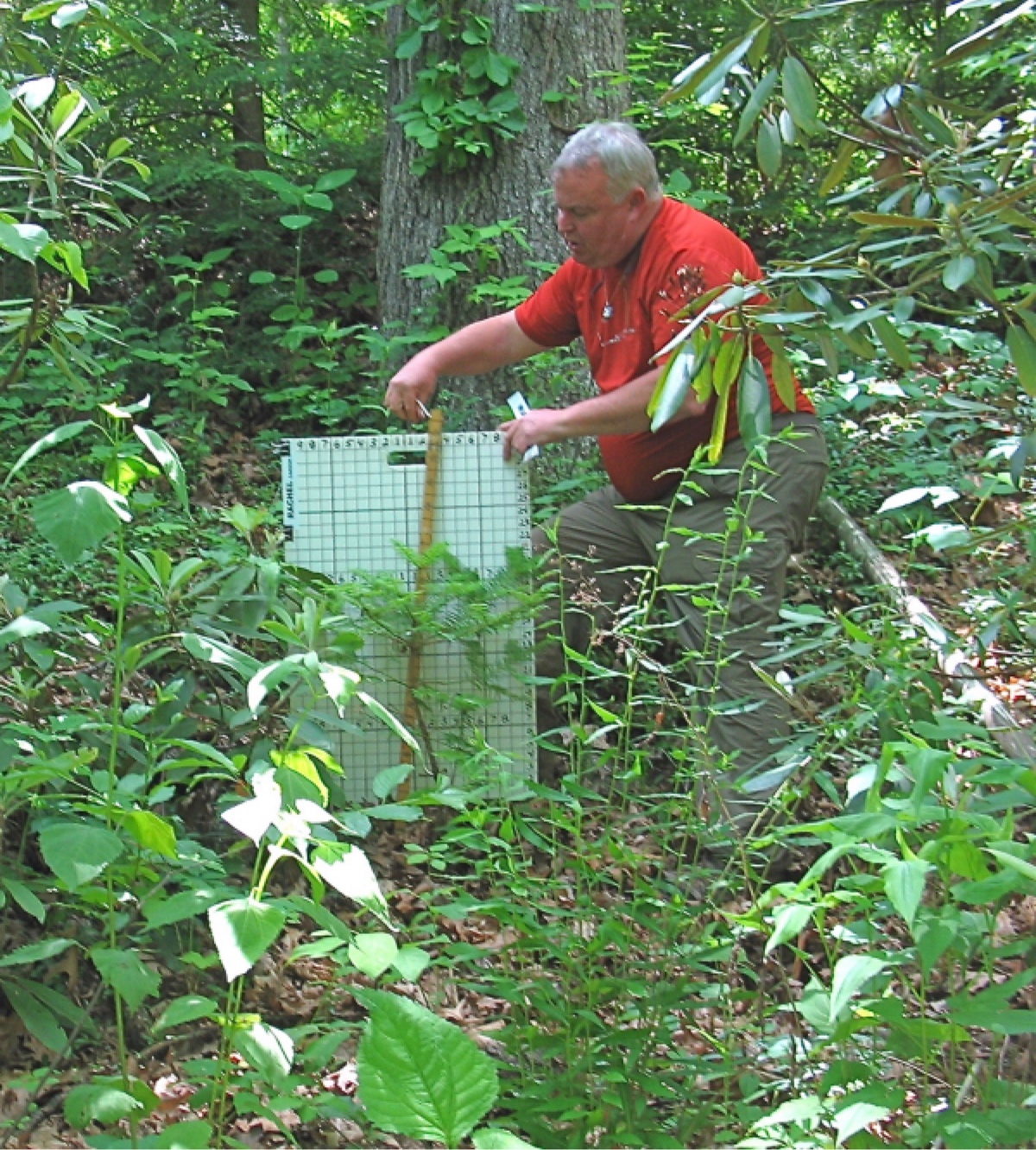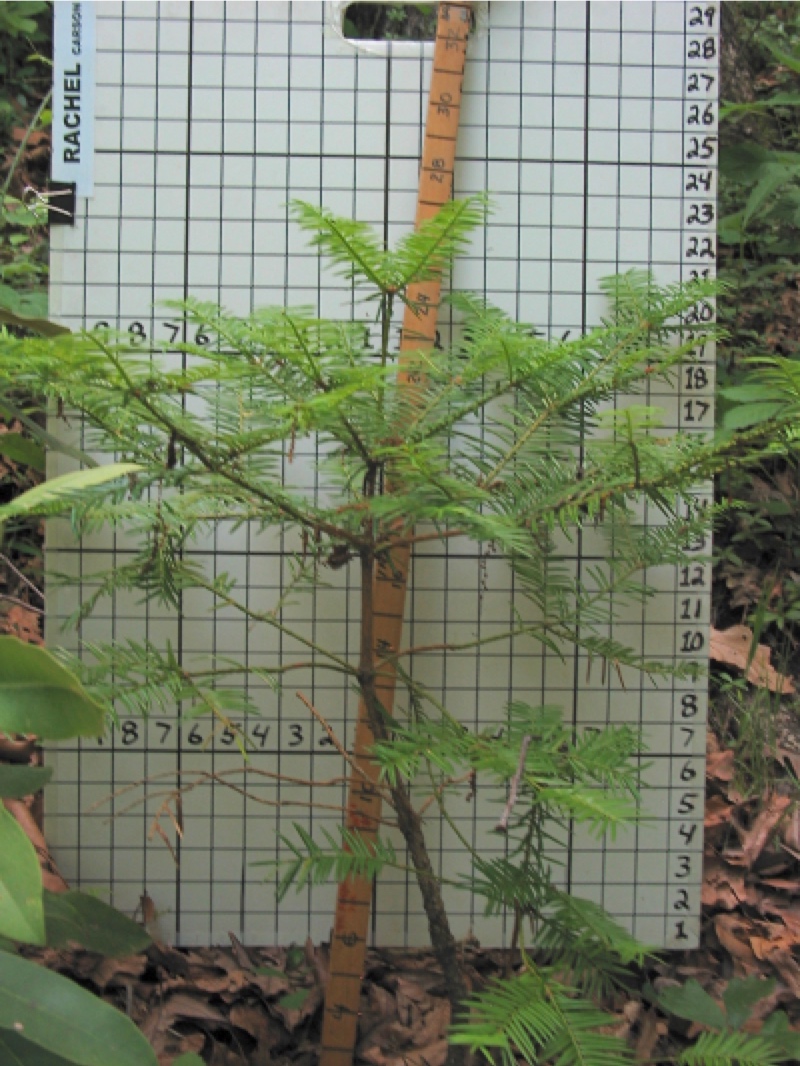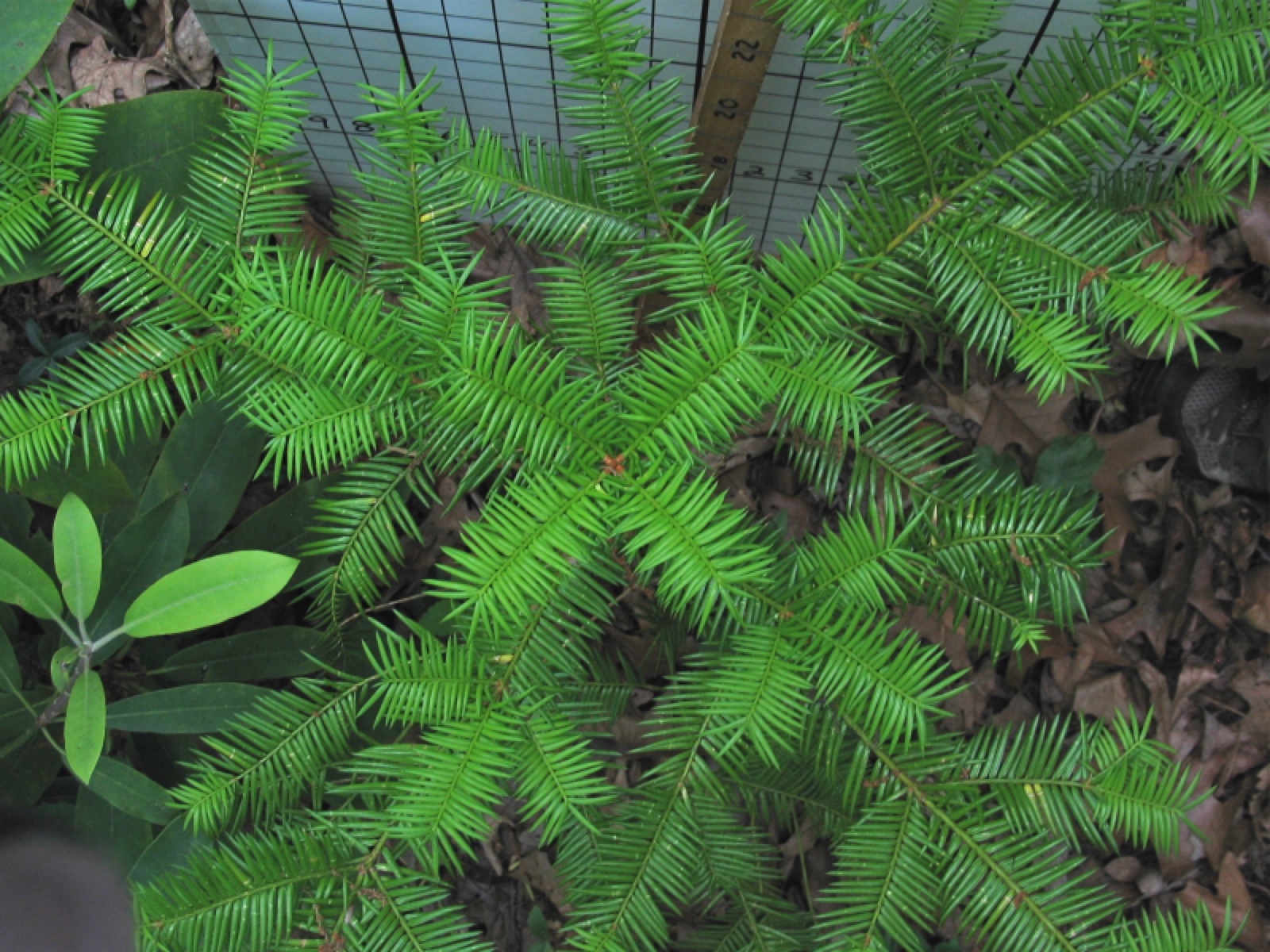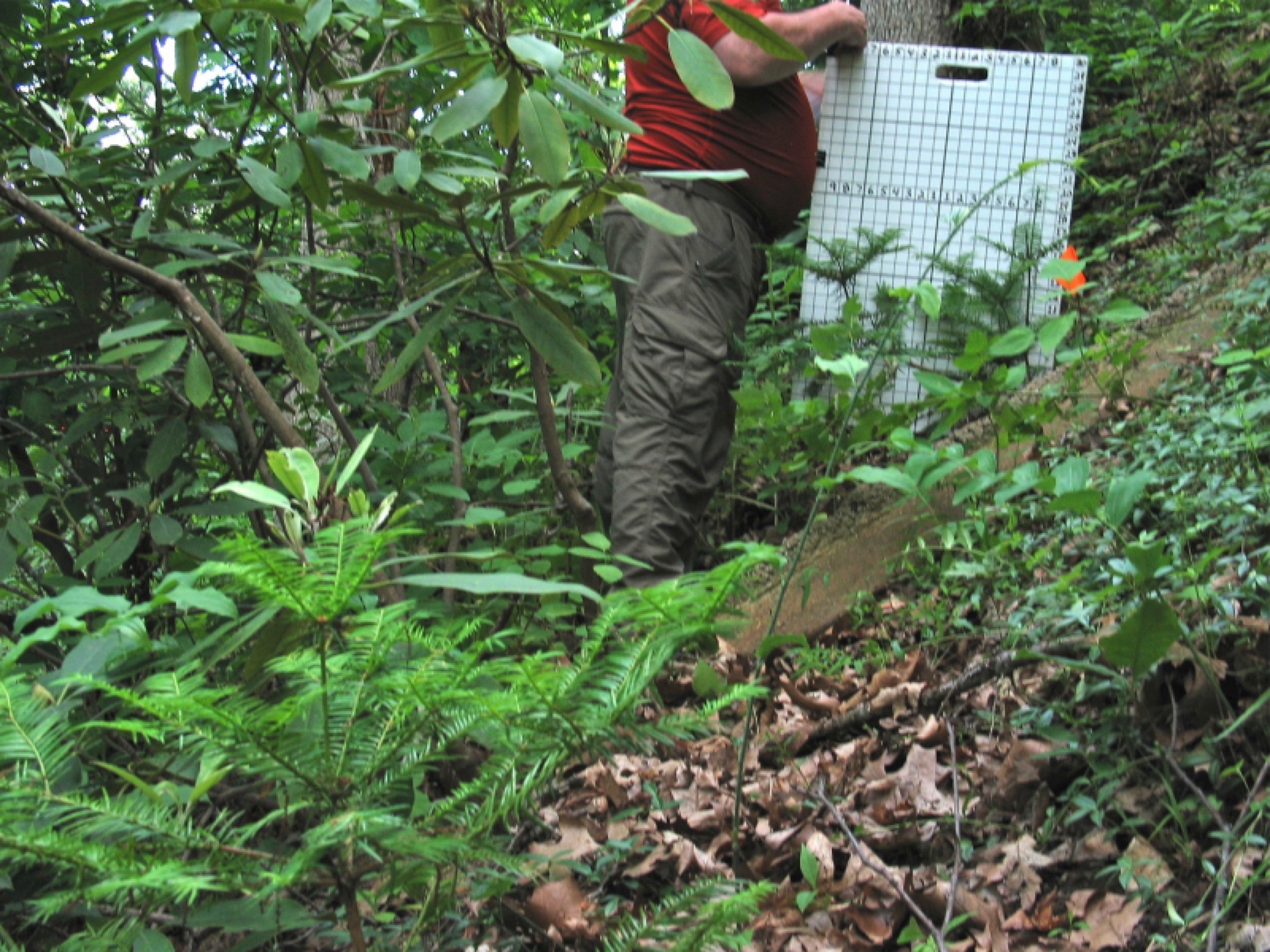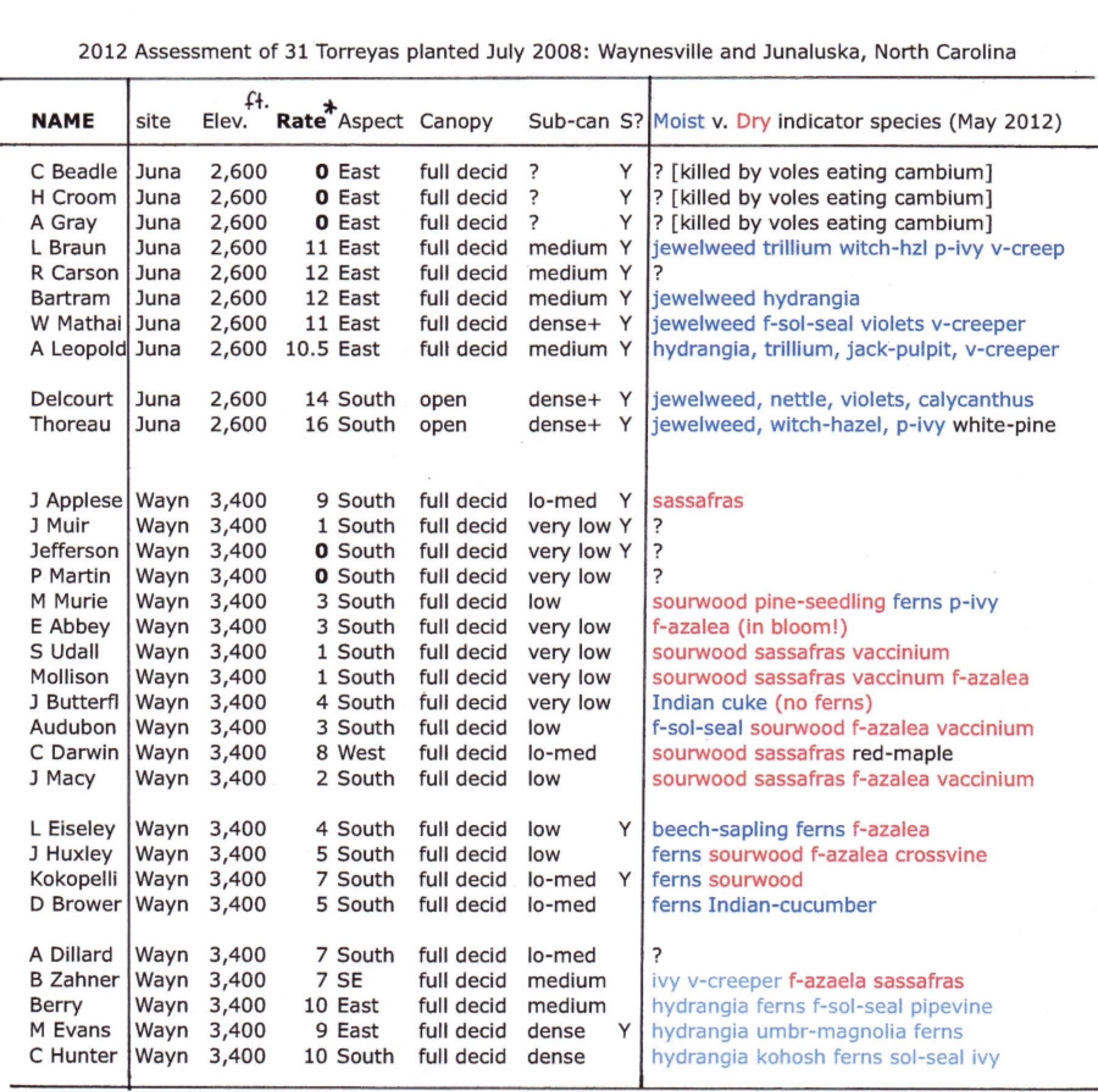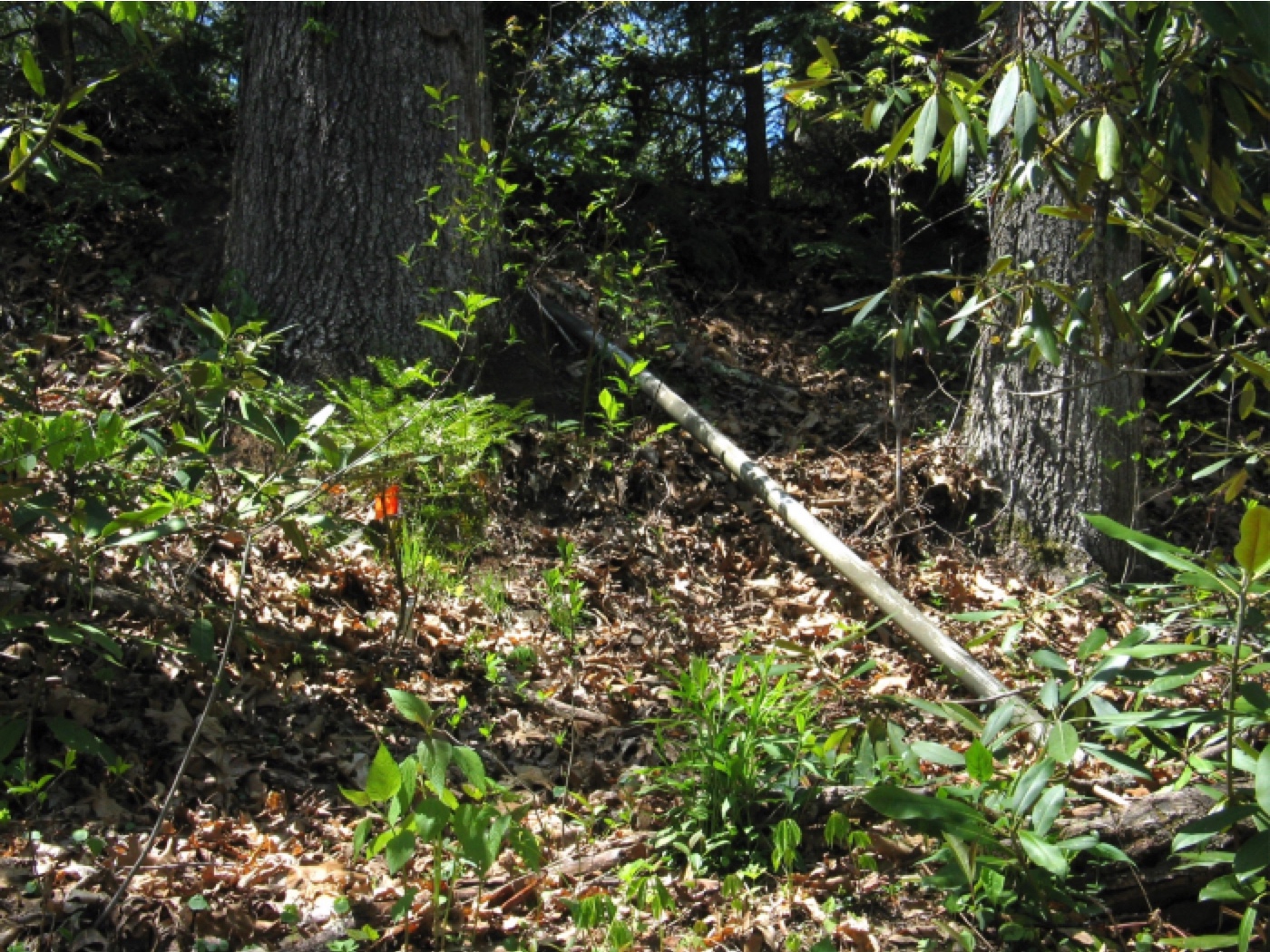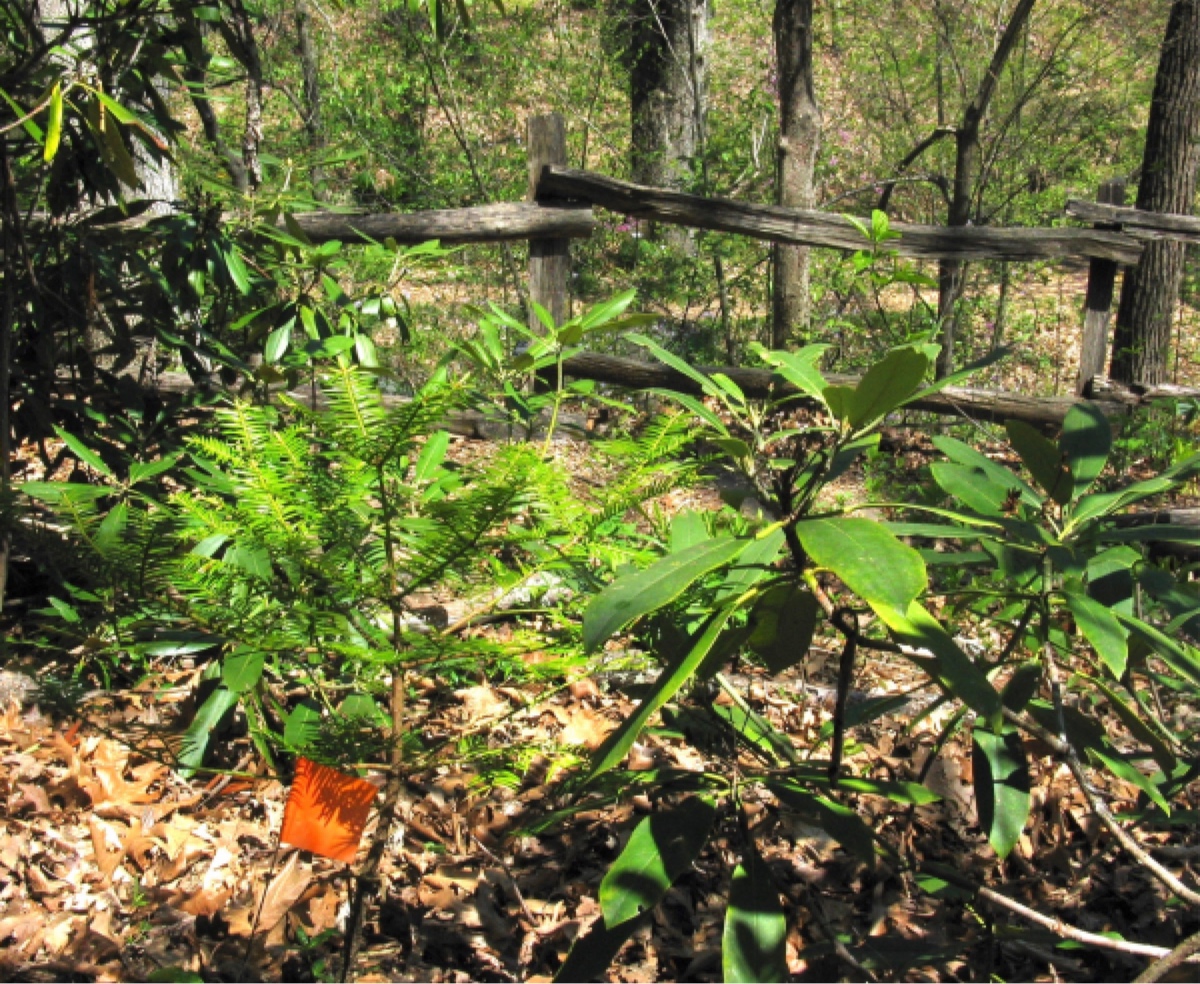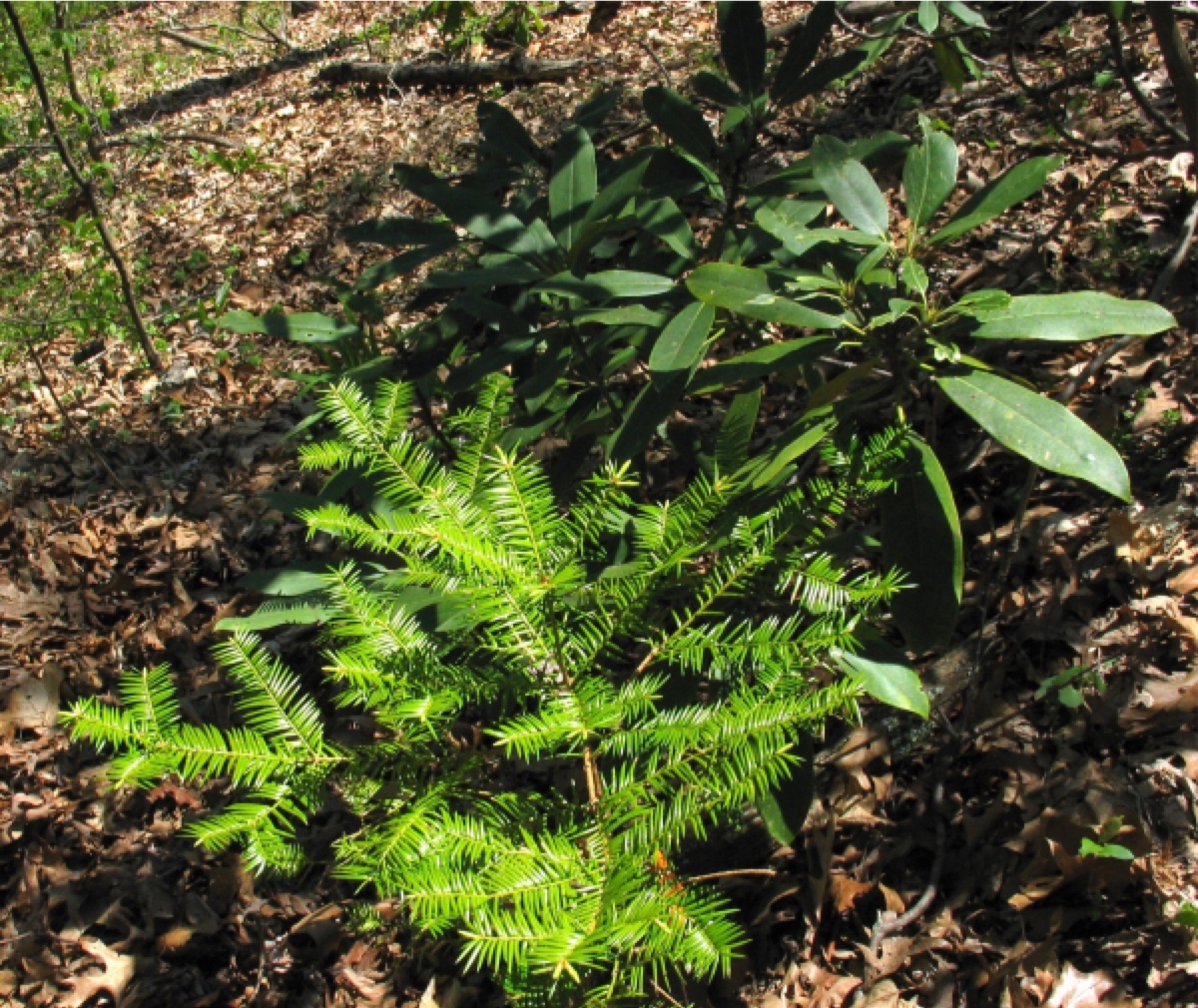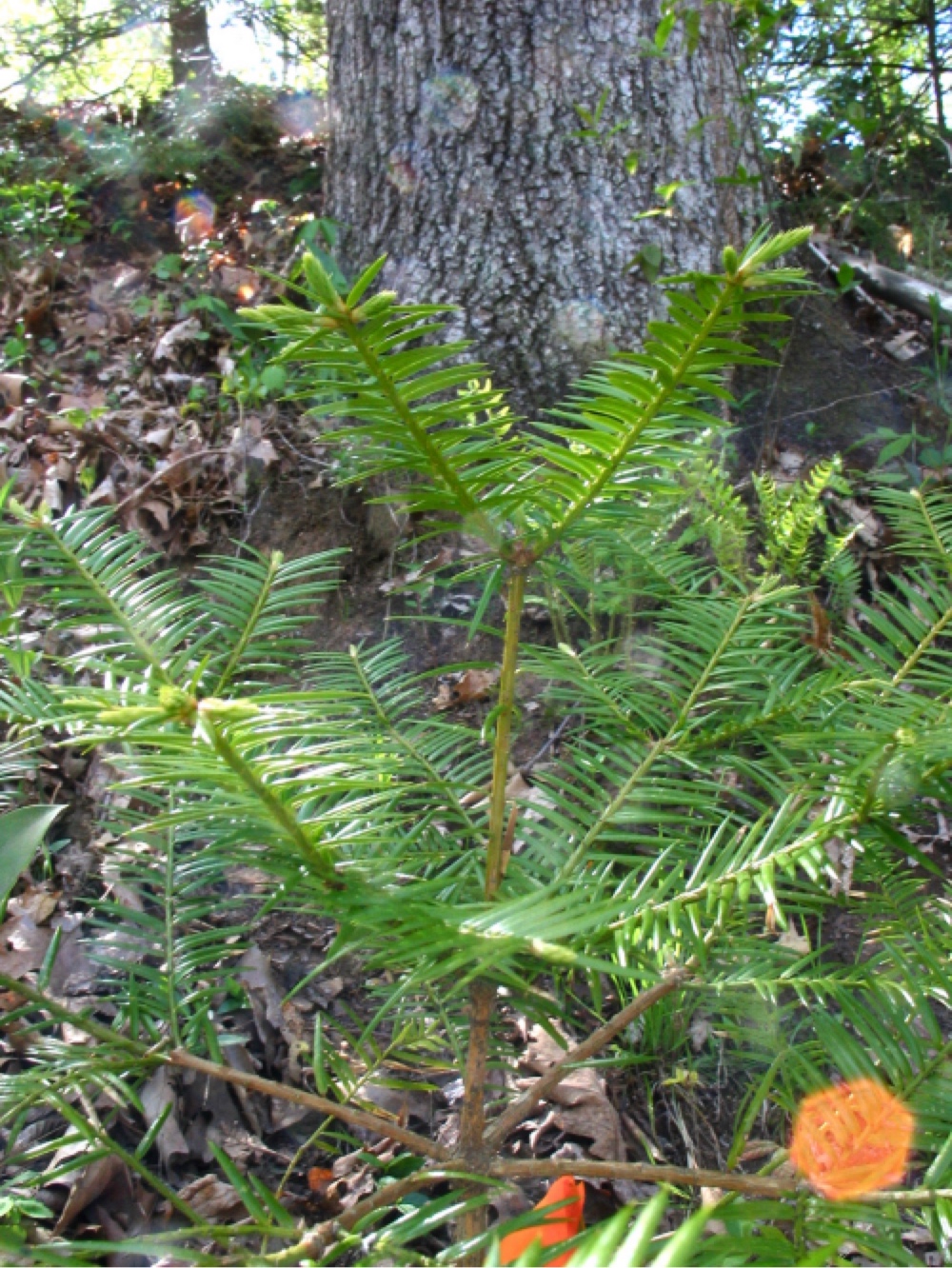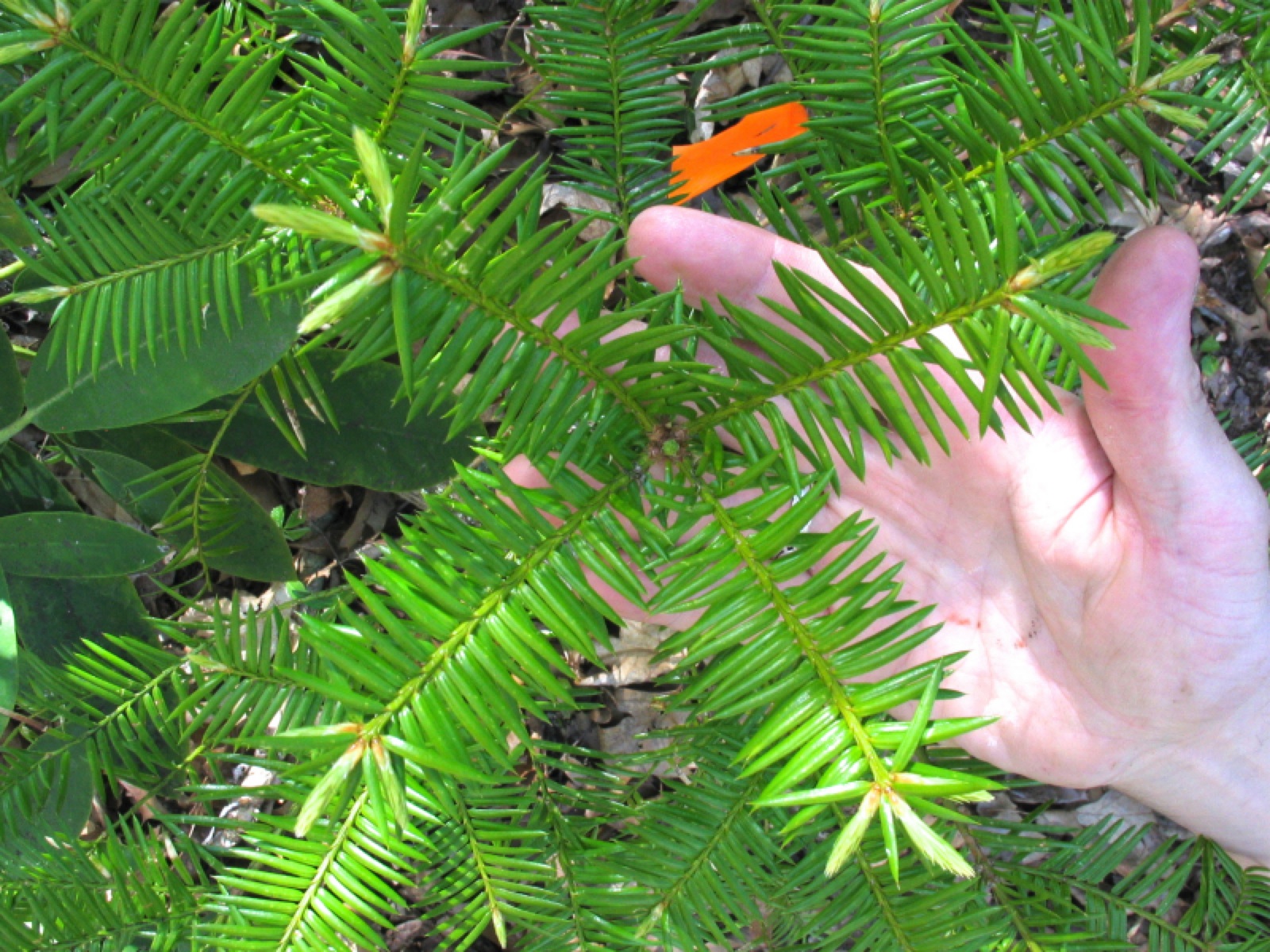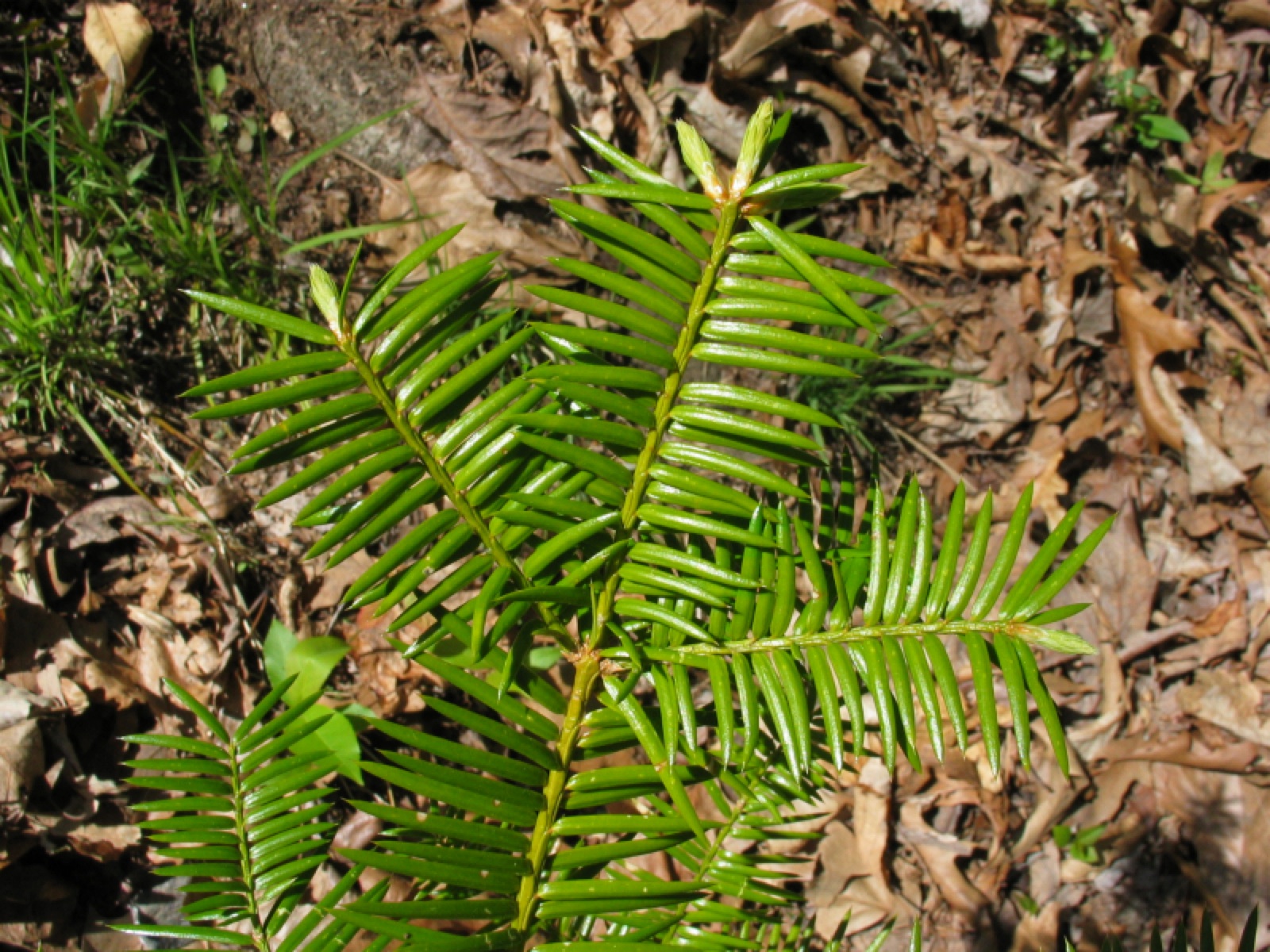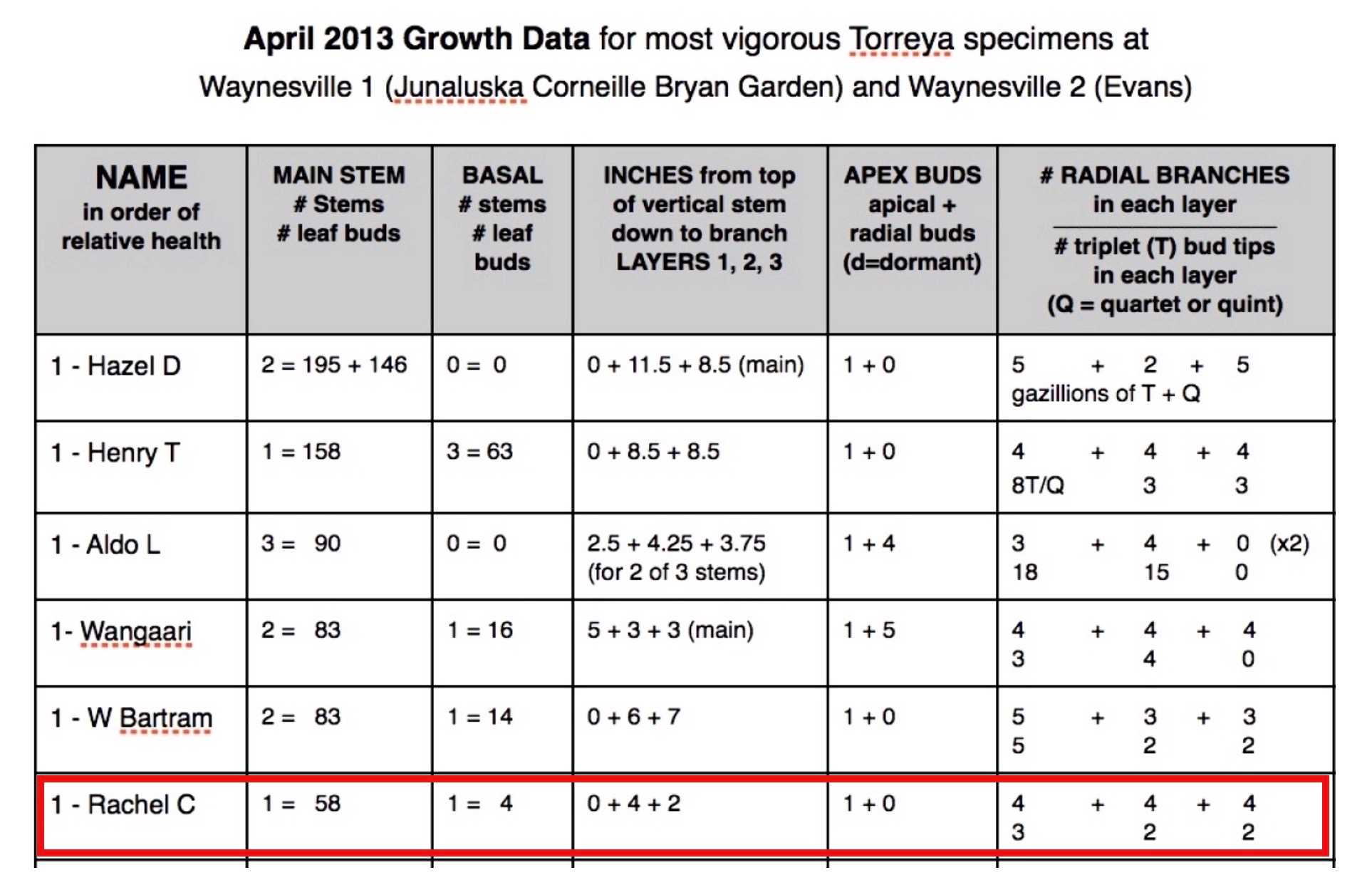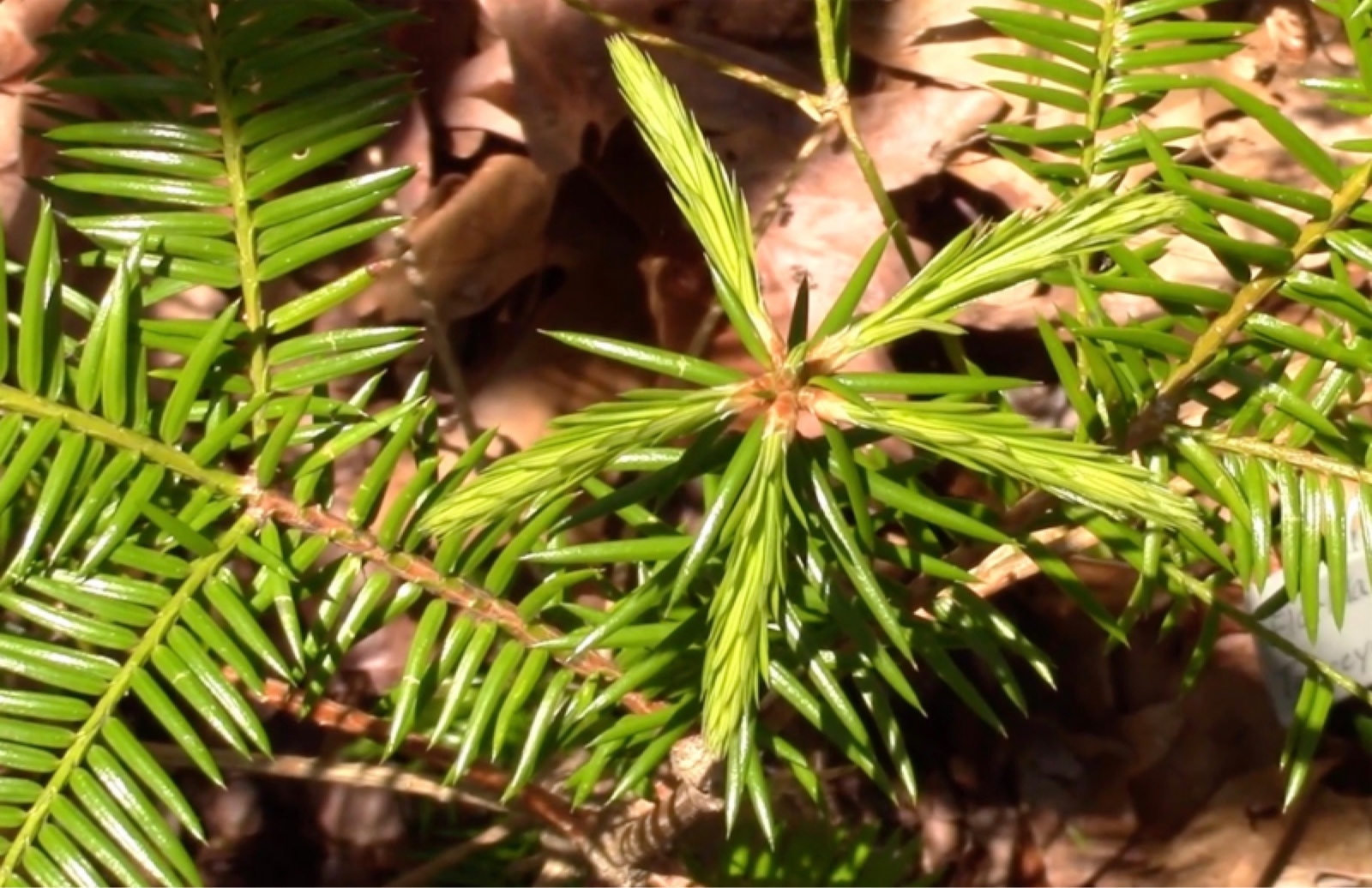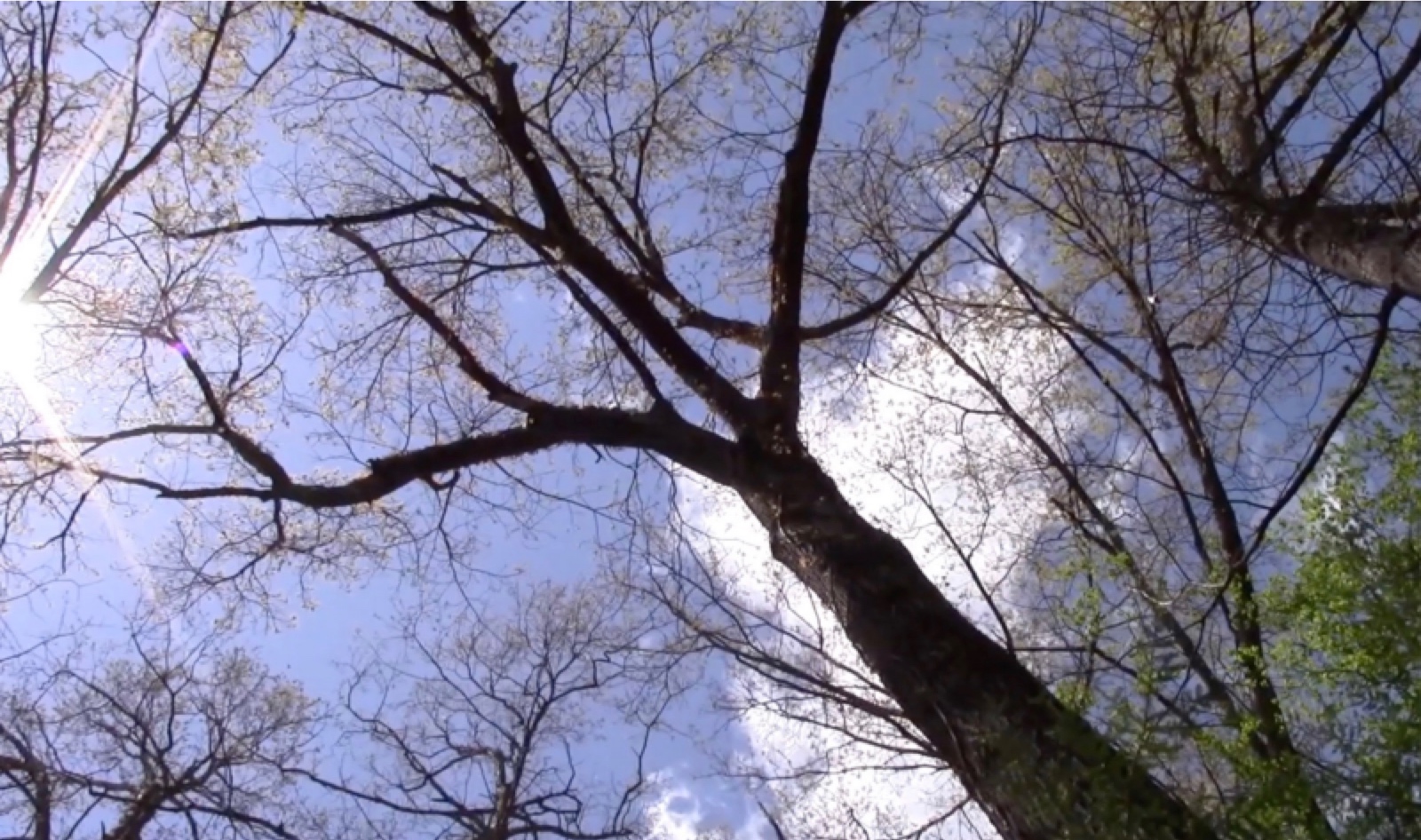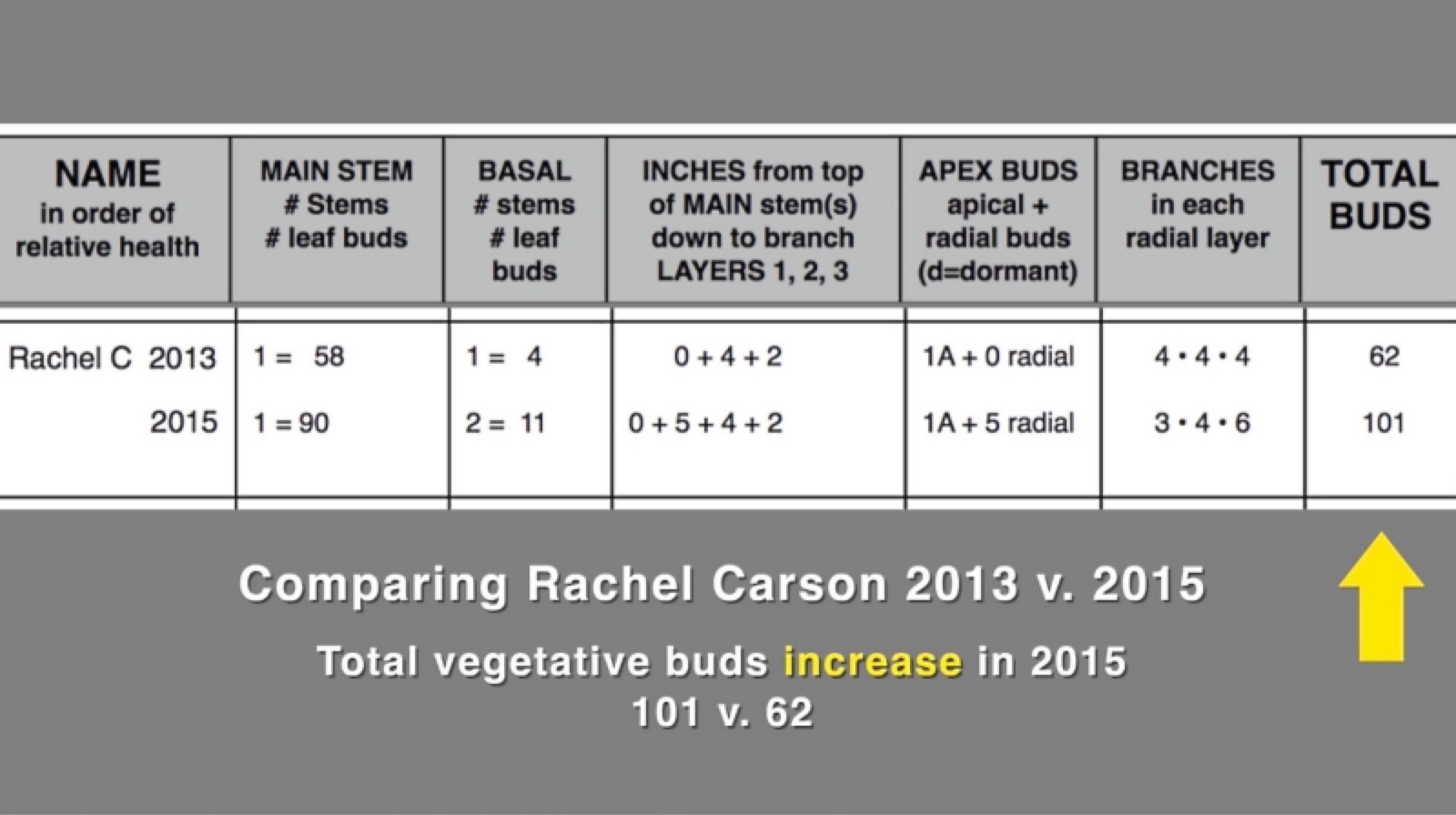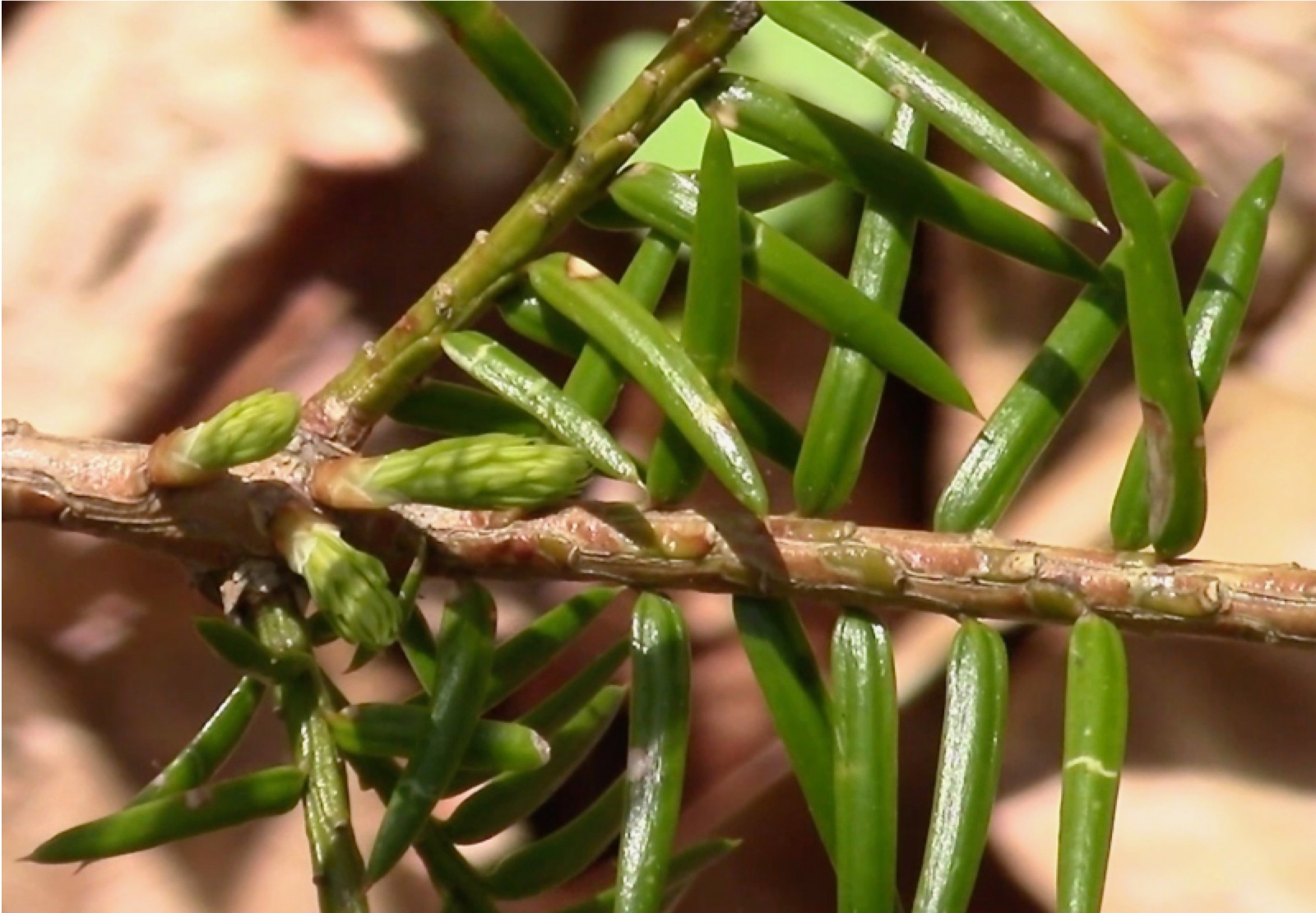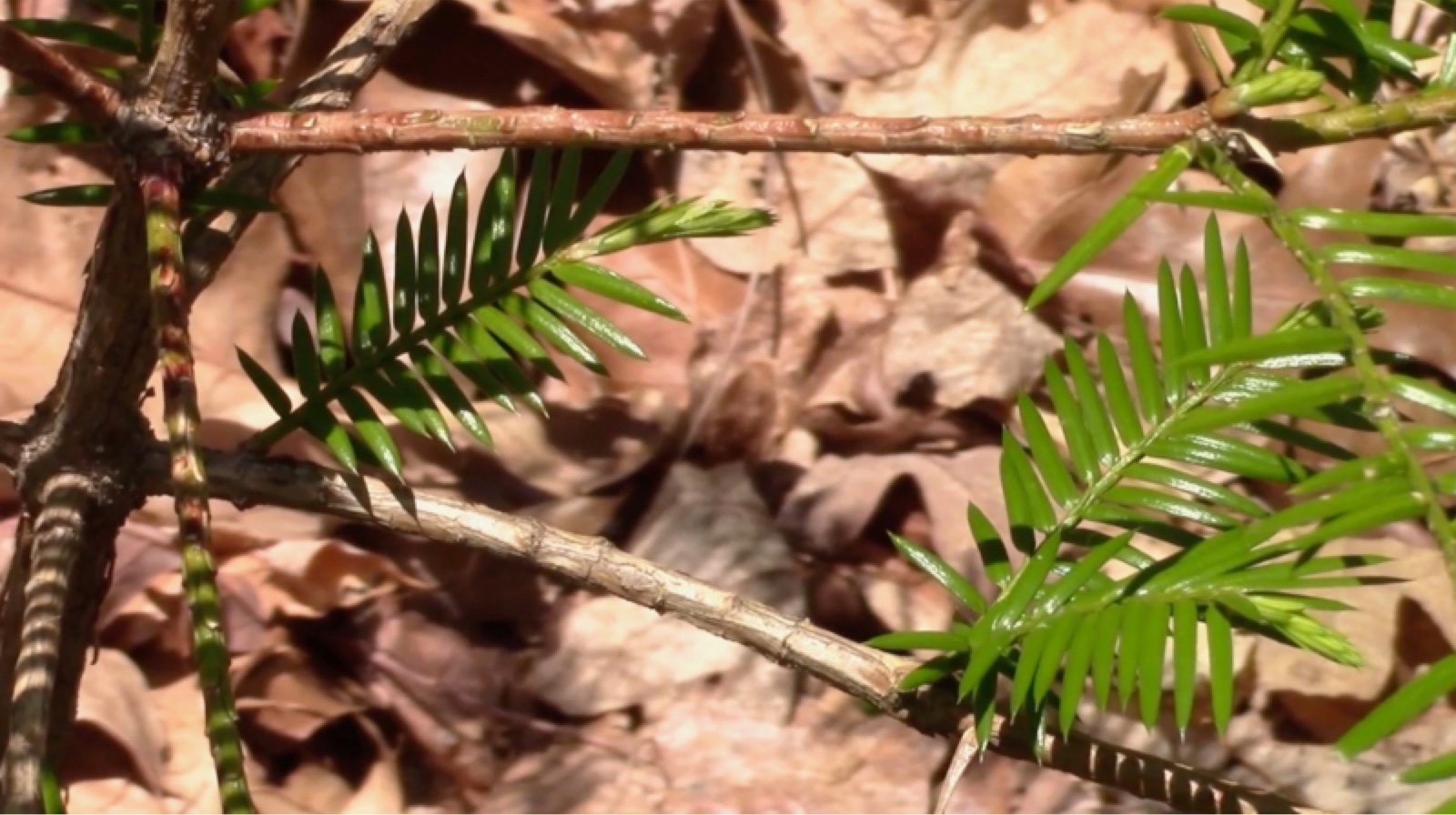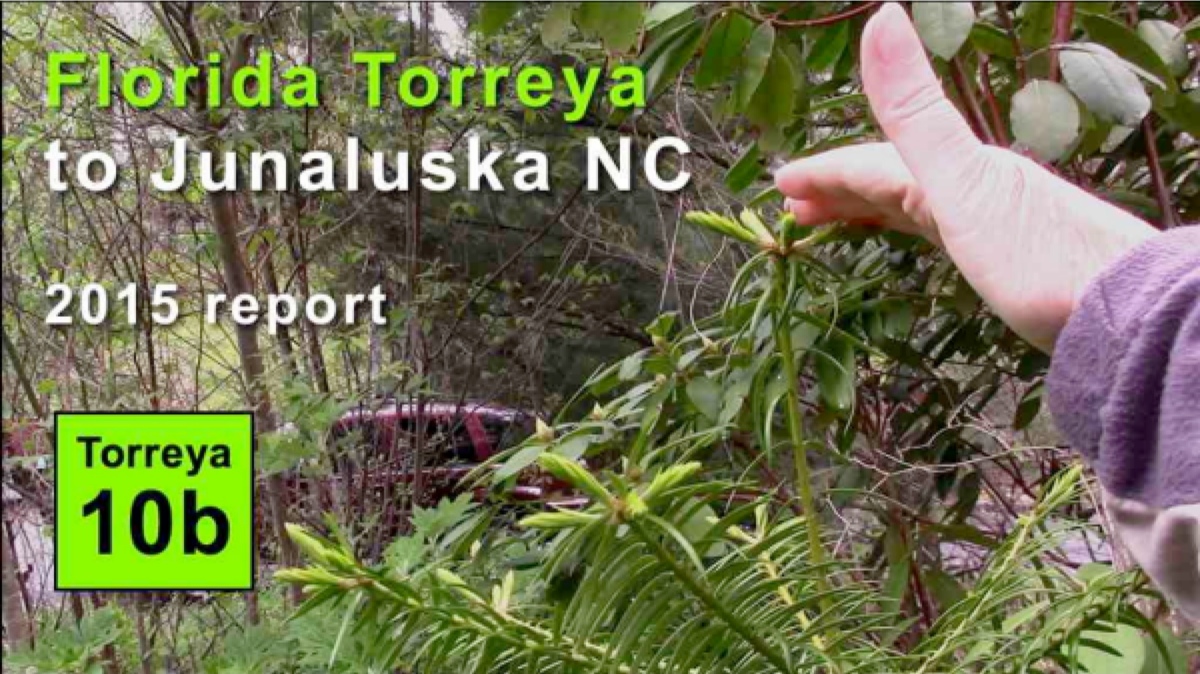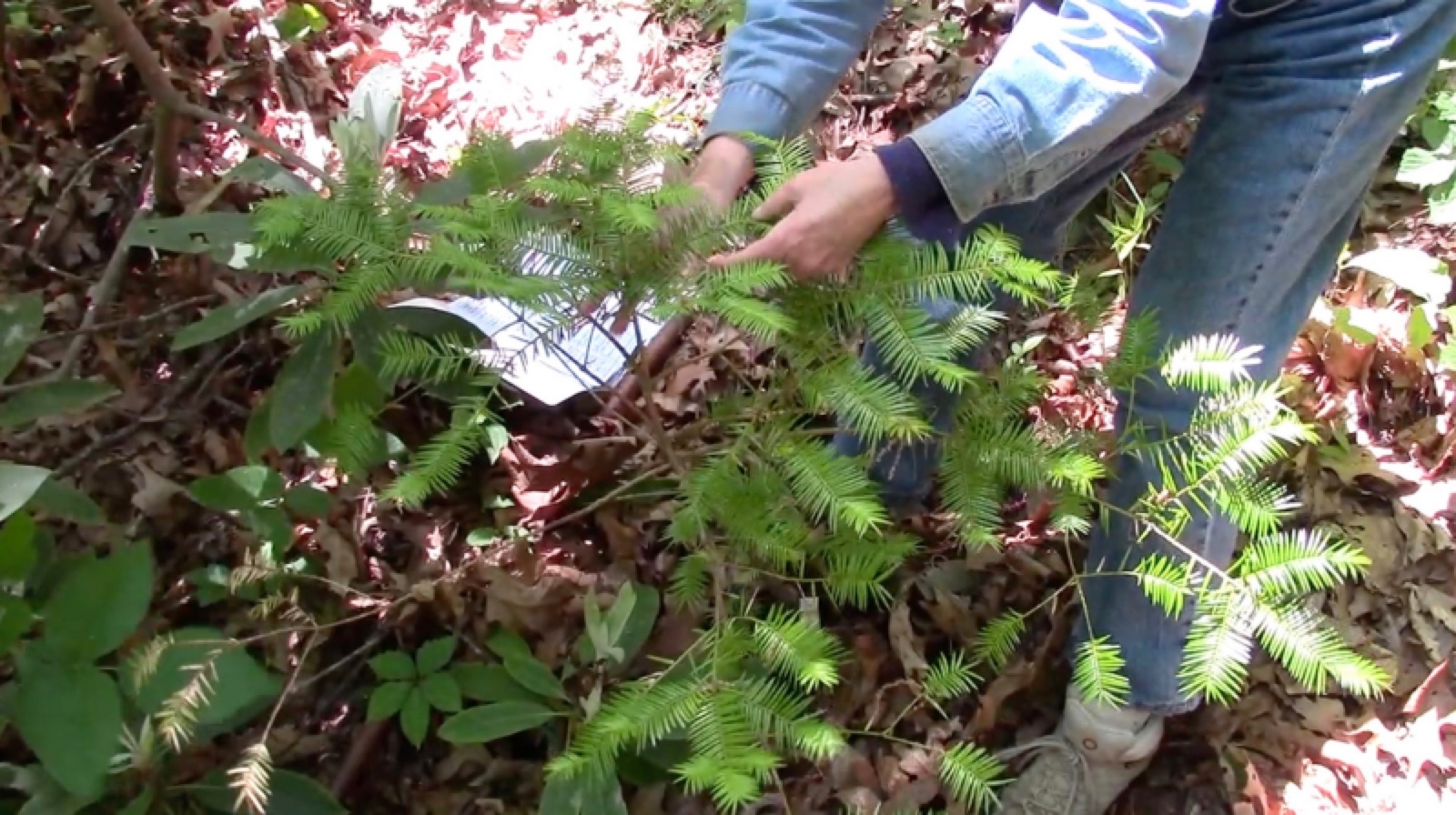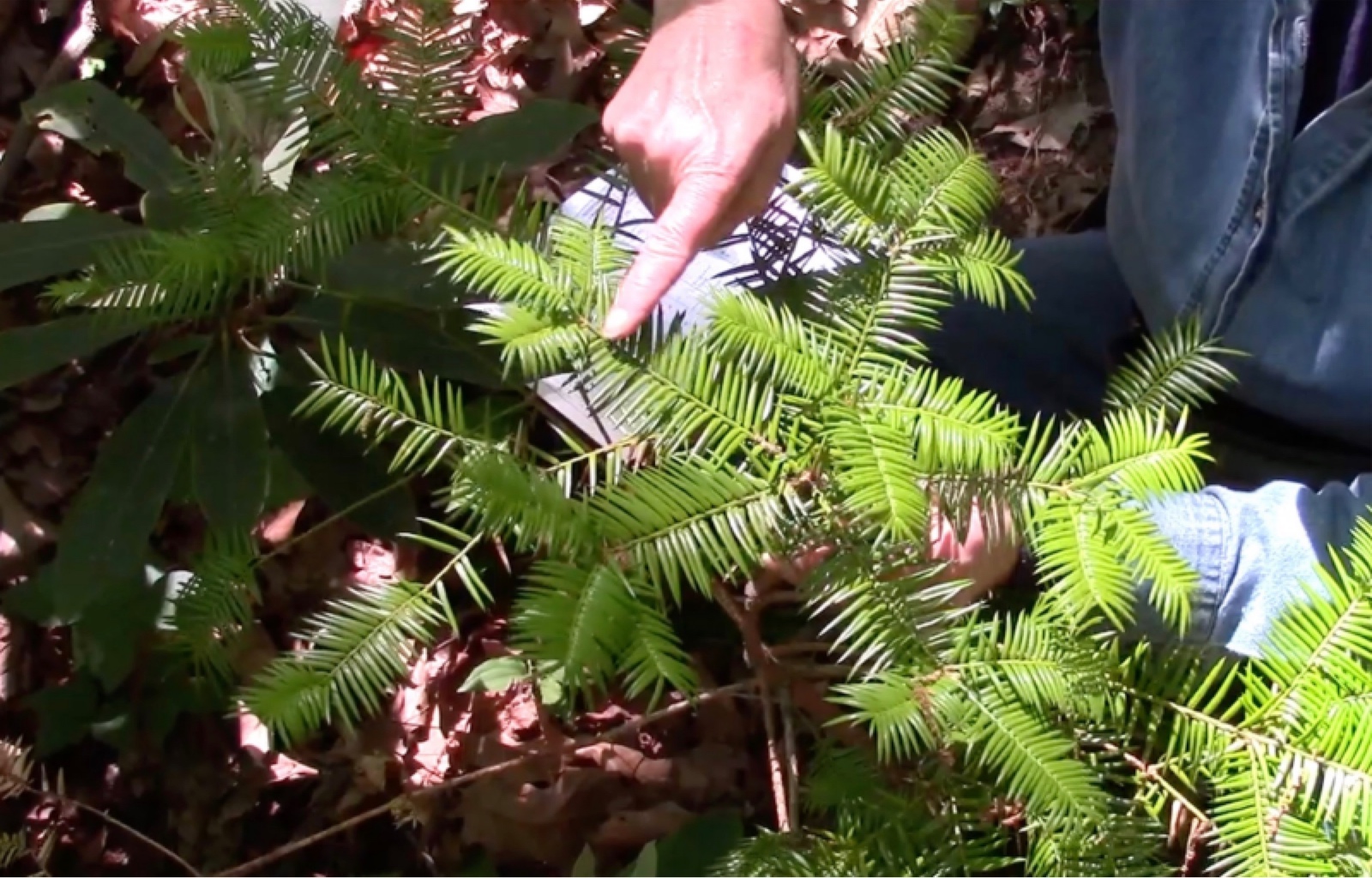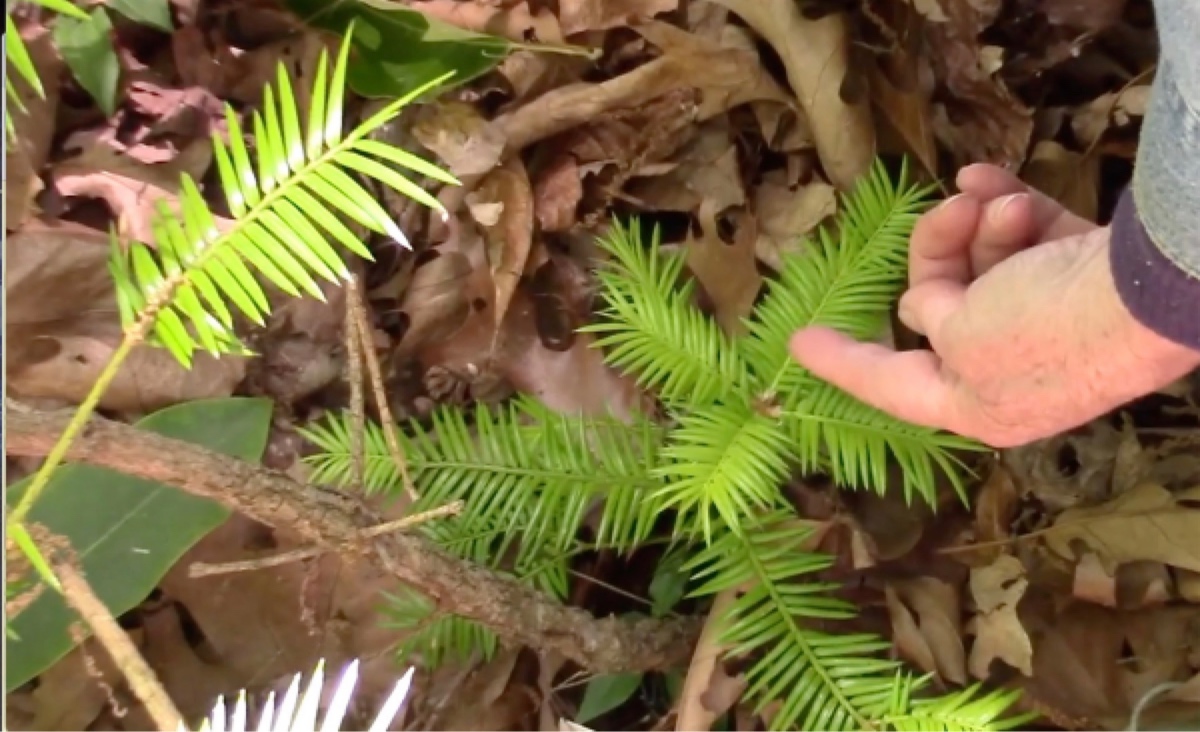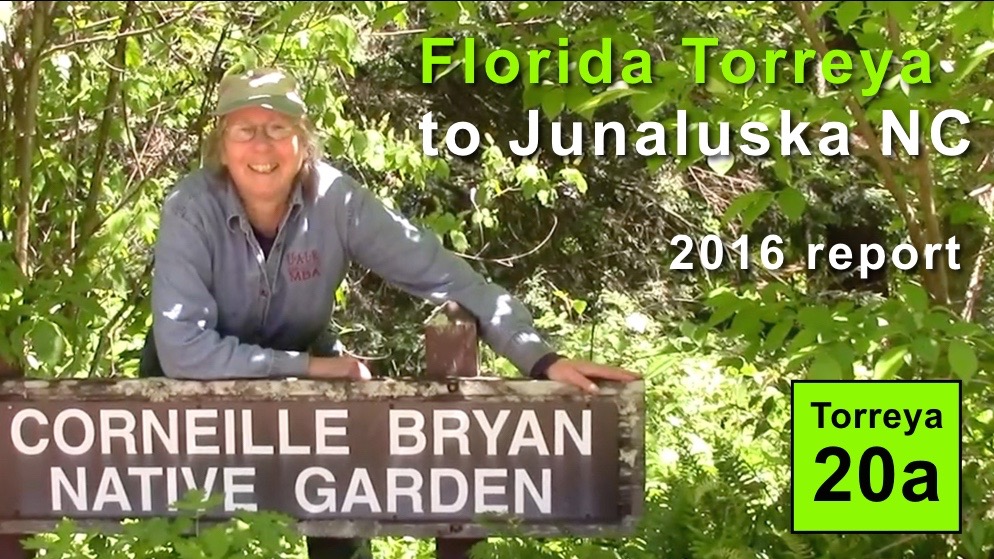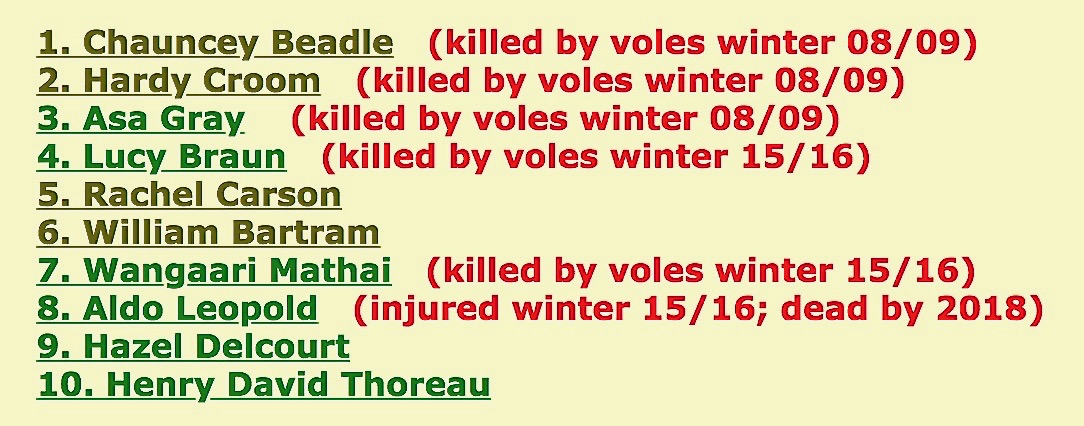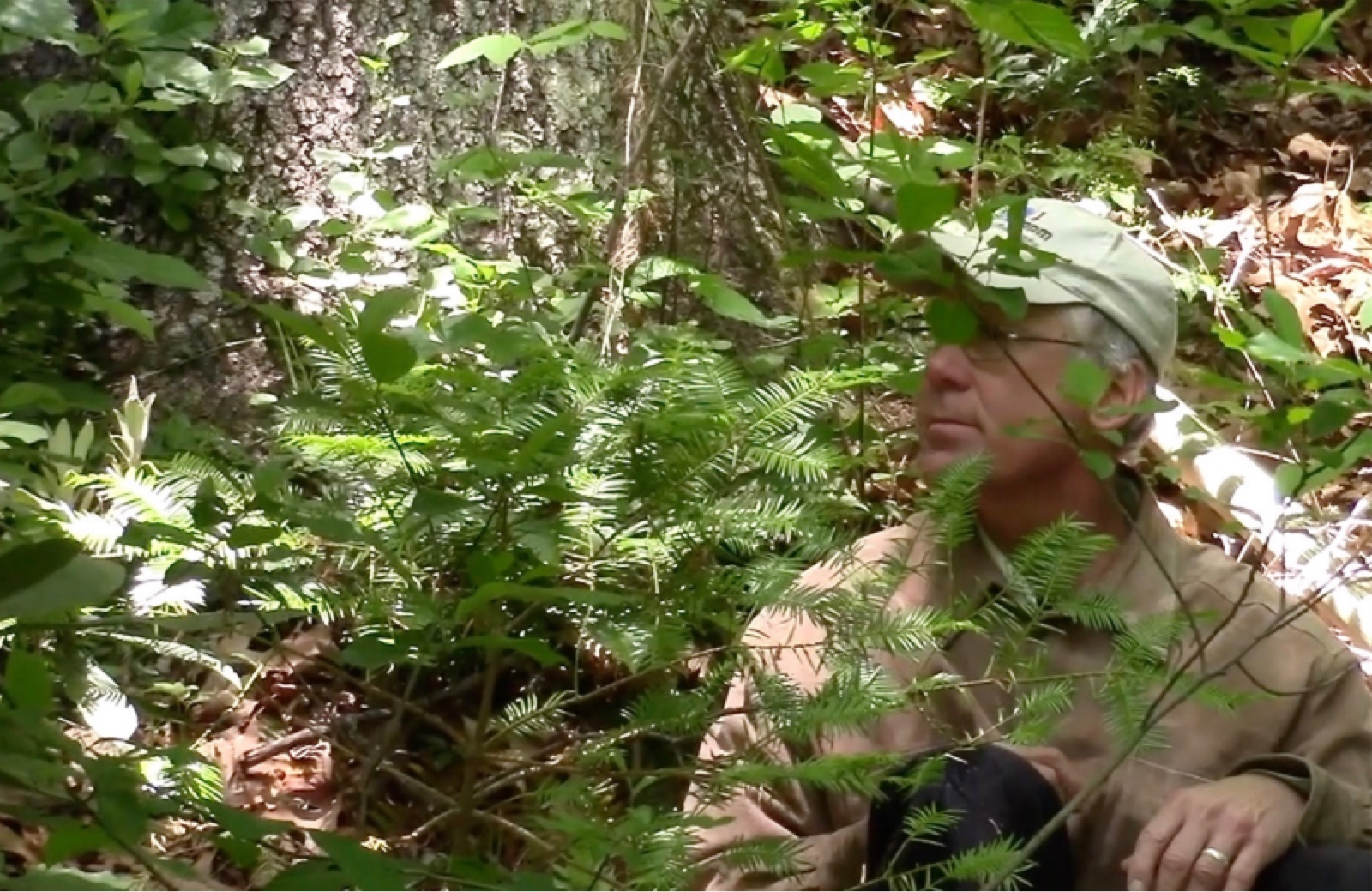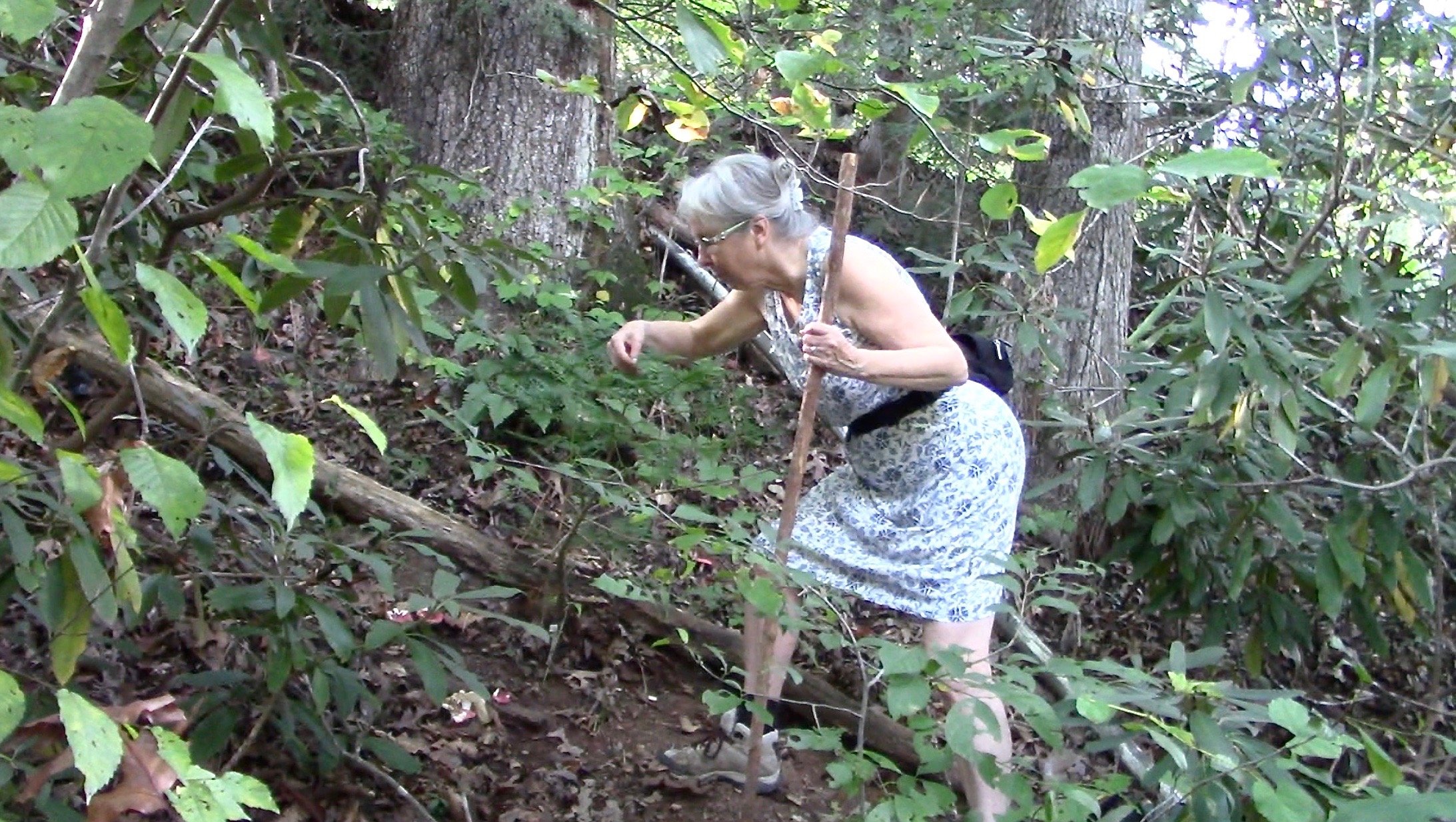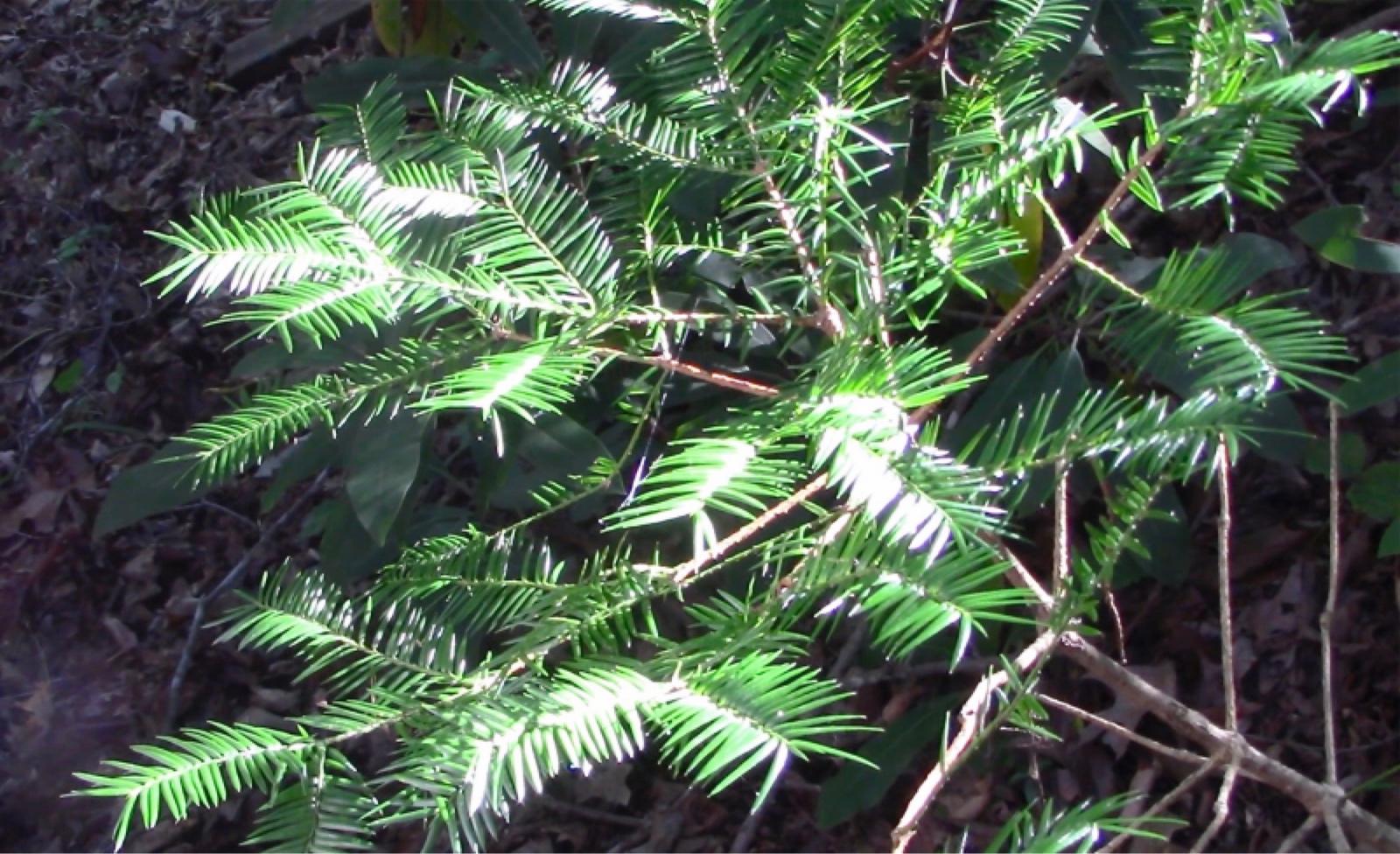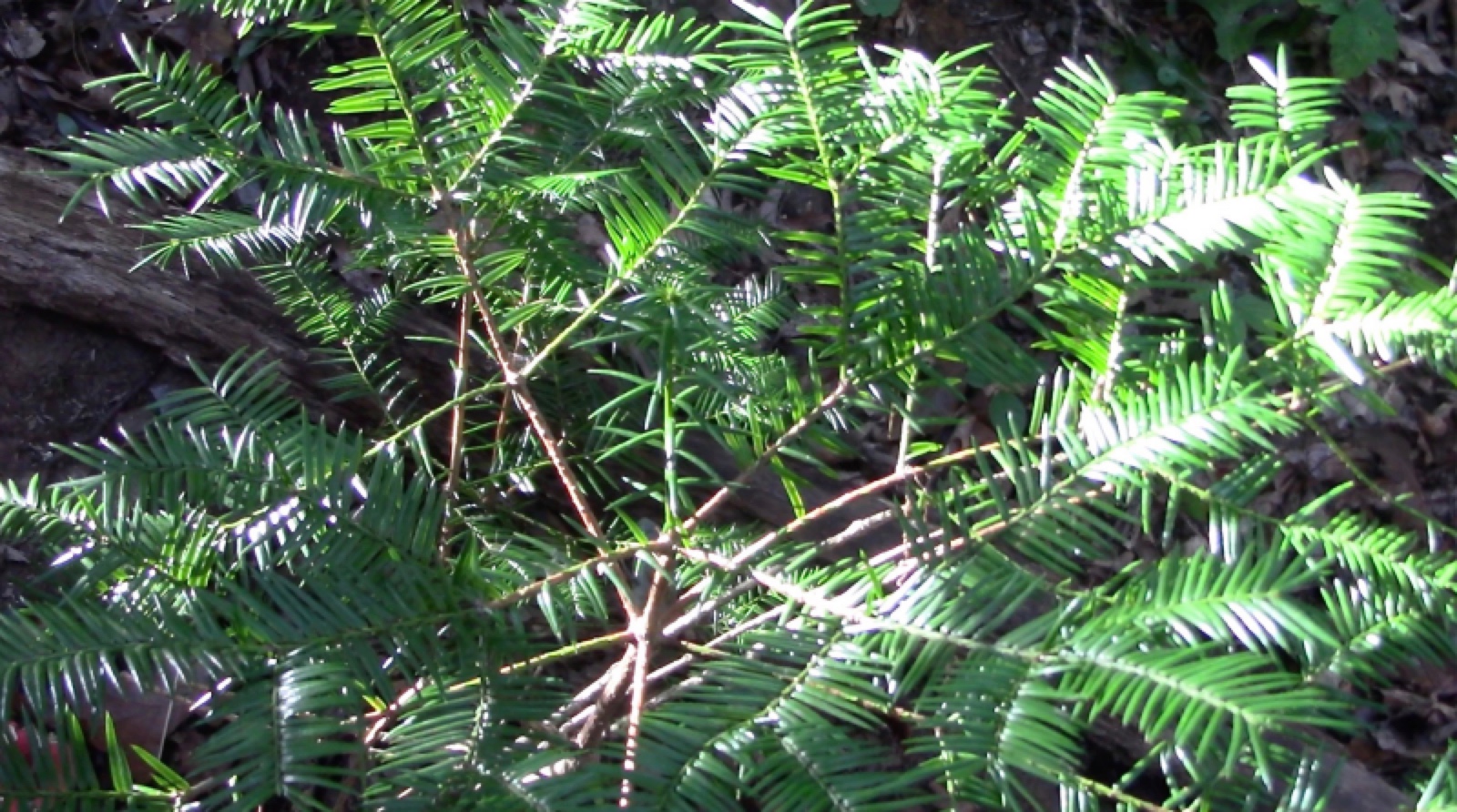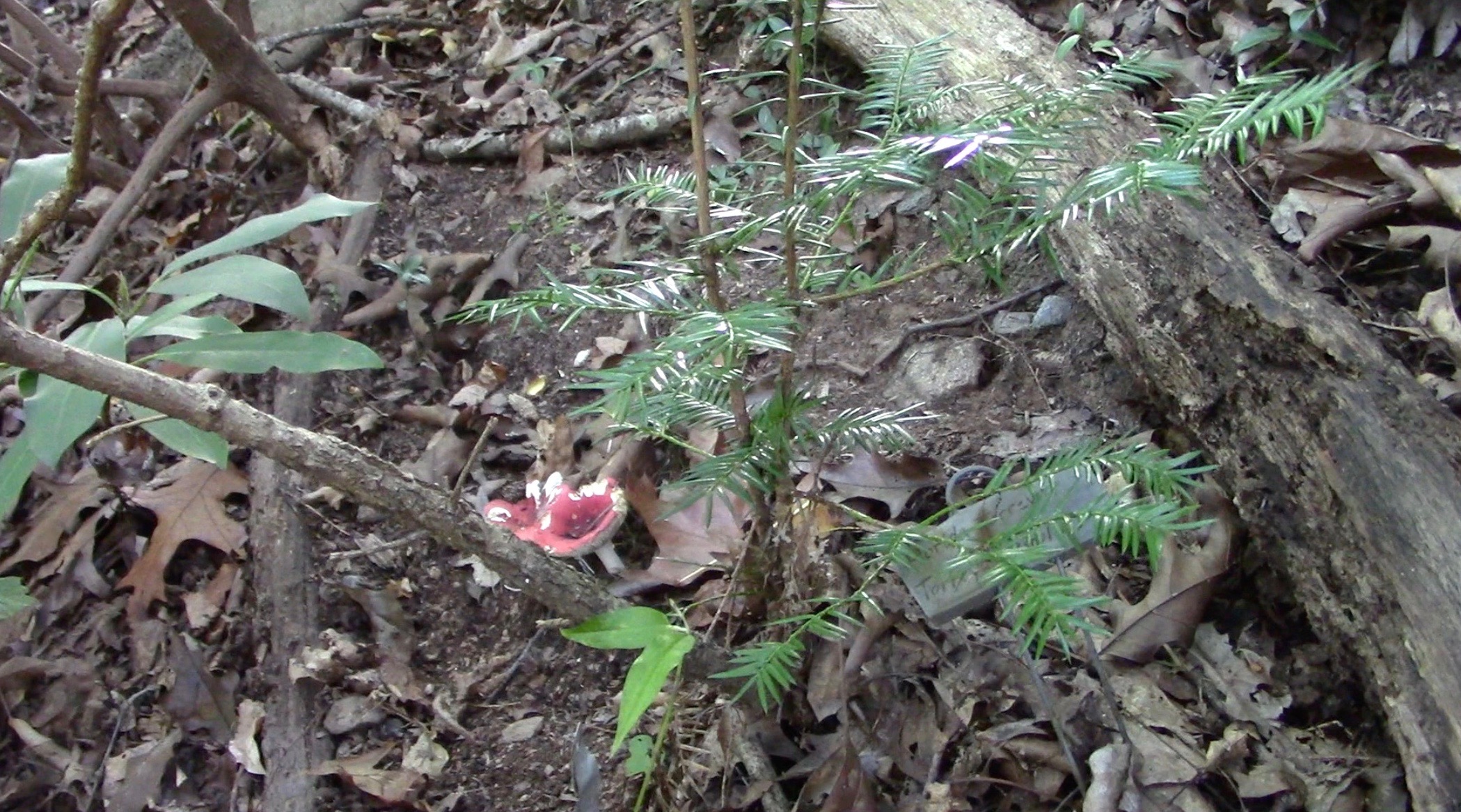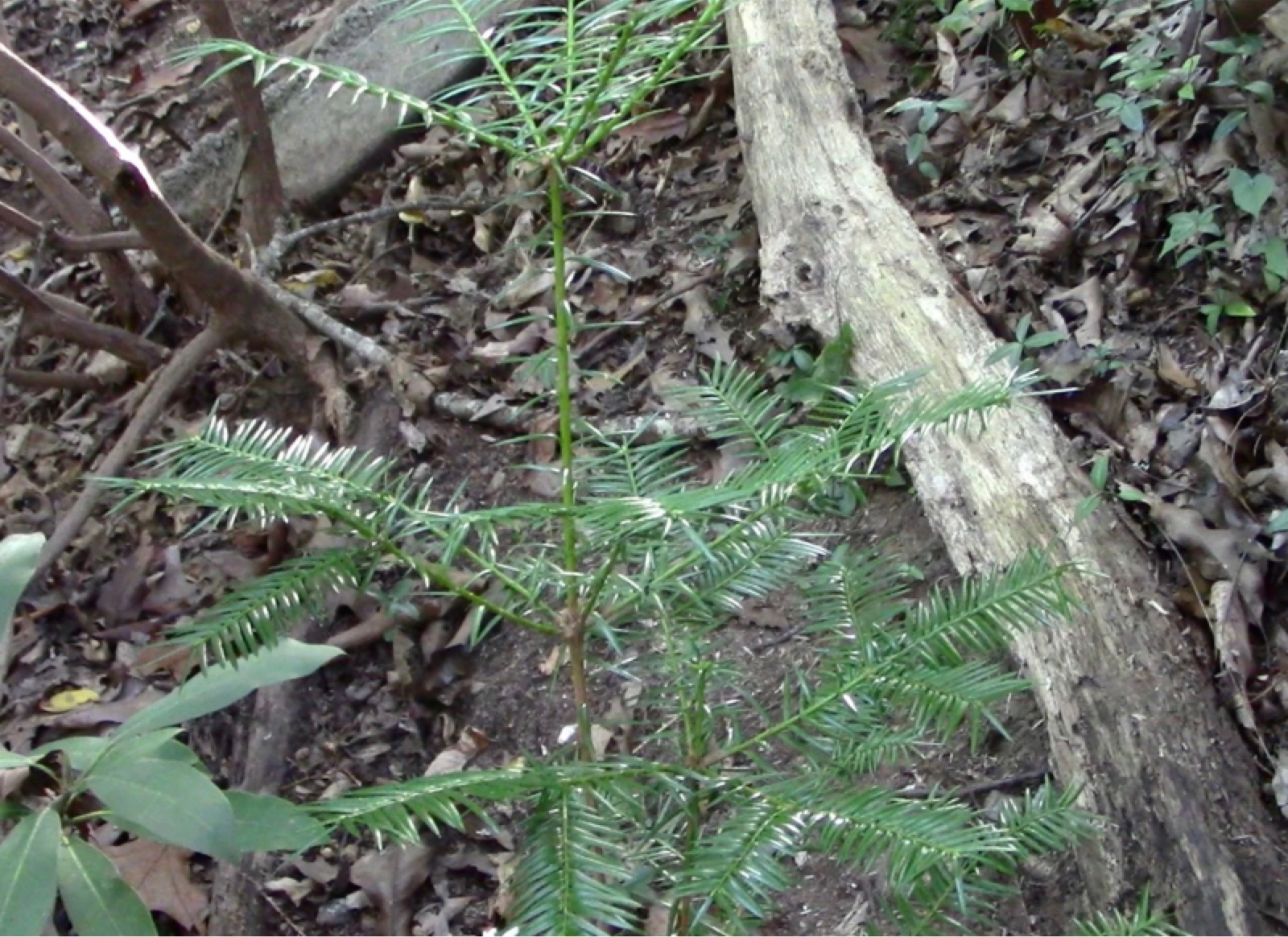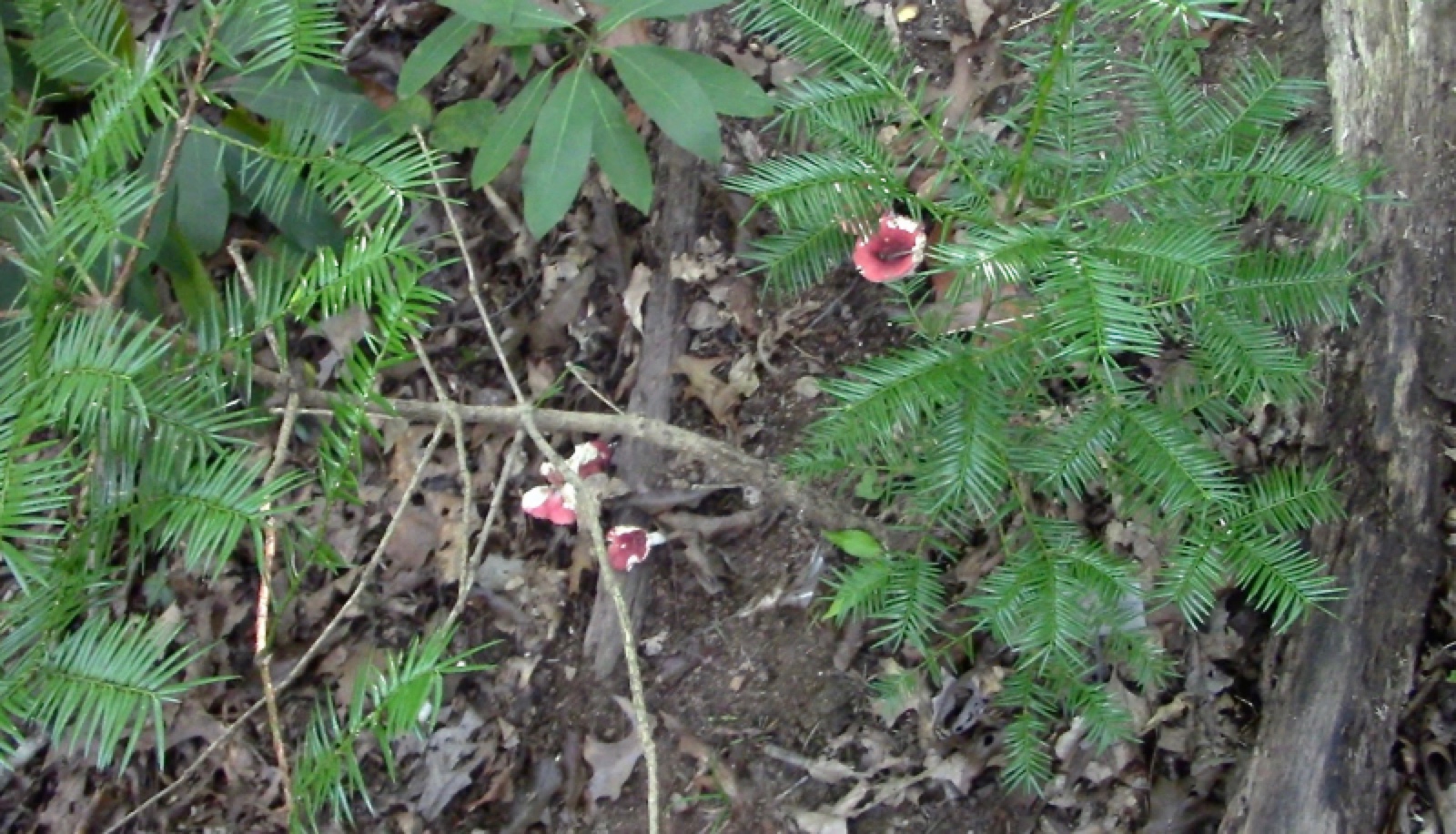|
Lake Junaluska, North Carolina (planted July 2008)
CORNEILLE BRYAN NATIVE GARDEN, Lake Junaluska. NE-facing slope of a NW-to-SE ravine with perennial creek at the bottom (2,600 feet elevation). The uppermost canopy is almost entirely deciduous, thus affording a lot of sun for evergreen growth in early spring, late fall, and mild winters.
Advance to TENTH ANNIVERSARY 2018 LEARNINGS here.
18 MAY 2012
ABOVE LEFT (May 18, 2012): Lee Barnes uses the same grid he created in 2008 to easily show height and growth pattern of each of the 10 potted seedlings planted at Lake Junaluska and the 21 at the Waynesville site nearby. Associated herbaceous plants are typical moist woodland species of this east-facing ravine slope. Notice the Rhododendron shrub in upper right of photo and another at far upper left. Rhododendron is an evergreen dominant in the subcanopy that can seriously block sunlight year-round. In the "learnings" section below we advise not planting Torreya anywhere near Rhododendrons. ABOVE RIGHT (May 18, 2012): On a scale in which Lee rated the "Celia Hunter" specimen at Waynesville a 10 the previous day (May 17), RACHEL CARSON is rated a 12. Notice the vertical, 7-inch-tall basal sprout. By 2018, this basal will become a co-dominant main stem, while the original stem will lean far to the left, always reorienting apex growth of the leader upward (creating overall a curve). Because genus Torreya regularly produces basal sprouts from its root crown, it easily adapts its form (and also its leaf patterning) to shifting light conditions.
ABOVE LEFT (May 18, 2012): Notice the abundant new (light green) growth at the outermost points of all three levels of radiating branches. In a shady, subcanopy site, such as this, a top-down view is the best way to appreciate the vibrancy of this specimen. ABOVE RIGHT (May 18, 2012): RACHEL CARSON is in foreground, with William Bartram back against the grid. A tall Rhododendron is visible in this image. Alas, it is on the southward side of Rachel and will at least partly block light penetration when the winter sun will be at a low angle.
ABOVE CHART: In 2012, Lee Barnes accompanied Connie Barlow on an assessment of all of the 2008 plantings on both the Junaluska and Waynesville sites. Connie asked Lee to use his judgment in rating each of the trees. Because they visited the Waynesville site first, two trees tied there for the highest rating on a scale of 0 to 10 (Thomas Berry and Celia Hunter). When they visited Junaluska, however, the torreyas were so much more vibrant that the scale began at 10.5 and went up to 16 for Henry David Thoreau. RACHEL CARSON was rated 12.
Spring 2013 photos below taken April 23, but spring was delayed nearly 2 weeks, so it is more like April 10. Thus, instead of light-green new growth photographed above in spring 2012, there is only light-green leaf buds to indicate the vigor of the plant. Even in northern states, Michigan and Ohio, we are finding that Torreyas tend to produce two spurts of above-ground growth if healthy: the first in the spring and the second August through September. In western North Carolina Connie has seen instances of new growth still soft and underway in late October and early November — so in the southern Appalachians a warm autumn might bring forth a third growth spurt.
ABOVE LEFT (April 23, 2013): Looking uphill from the trail. "Rachel" Torreya is marked by the orange flag. Large shaded trunk of Red Oak immediately behind; White Oak to the right.
ABOVE RIGHT (April 23, 2013): View of Torreya looking downhill toward trail, which is just in front of wooden fence. Notice the Rhododendron immediately to its right.
ABOVE LEFT (April 23, 2013): Looking down onto Rachel, which is still a single stem, with Rhododendron alongside.
ABOVE RIGHT (April 23, 2013): Side-view of the upper growth layers of Rachel. Notice that the central stem gained 4 inches of vertical height last year and then added a flush of radial growth (4 lateral branches) around that new apex. The visible green buds will create a second extension of the young branches at the top whorl this year.
ABOVE LEFT (April 23, 2013): Looking down onto the uppermost whorl of young branches. The apical bud in the center is quite small, but given that it is green (rather than brown) it is likely to send up new vertical growth in late summer.
ABOVE RIGHT (April 23, 2013): Tip of branch of third radial layer down. The triplet branchlets bear a single bud at the tip of the two side growths, but a triplet at the tip of the center lateral.
NEW MEASURE OF HEALTH IN 2013: leaf bud count = 58 on main stem and only 4 on the ancillary basal stem. See chart below. Notice that the photo above left clearly shows that three of the top whorl of branches bear triplet buds at the tip, and one has a doublet. The right-most column of the chart below confirms this, as a careful count of buds and their locations was made in 2013.
ABOVE (April 25, 2015): Apex is growing both a new vertical leader as well as 5 radial branch starts. View directly up from Rachel Carson Tree; the big Red Oak has not yet leafed out, so spring sun is intense.
BELOW (April 25, 2015): Vegetative buds are not only at the tips of branches, but also on older branch segments where sun is encouraging. The set of young branchlets along the oldest branch segment, right next to the main stem, grew the previous year. So Rachel is filling in photosynthetic capacity, rather than just building upward and outward. Note: On the two biggest torreyas (Hazel and Henry) I found an uncountable number of inner-stem vegetative buds of all sizes in 2015, so that was the last year that I made such a count.
ABOVE: Rachel has tall rhododendrons both to her left and her right. She is letting the old branch in the far lower left corner die because the rhodie on that side is southward, blocking the sun. BELOW LEFT: Rachel Carson is expanding horizontally, which is typical of a subcanopy tree angling for sun. Connie points to the second whorl of 5 radial branches — all five of which grew a set of triple branchlets at their tips. This is a sign of great health. BELOW RIGHT: At the upslope and right side of the main stem, Rachel is finally putting some growth onto a basal: 12 new growth buds in 2016, 11 in 2015, compared to just 4 in 2013.
While filming here in 2016 Connie Barlow discovered that tunneling, root-eating rodents had killed over winter two previously very healthy torreyas: Lucy Braun and Wangari Maathai. (See list, below.) All 6 of the rodent-killed trees were closest to the SW corner home that had a hanging birdfeeder in 2016, which Connie hypothesized as the cause of a boom-and-bust rodent cycle in this seasonally occupied neighborhood.
ABOVE RIGHT (May 21, 2016): Michael Dowd sits alongside Rachel Carson Tree. A large Red Oak is directly behind them.
ABOVE (October 7, 2018): Connie Barlow inspects Rachel Carson. Tree trunks in background are Red Oak (left) and White Oak (right).
ABOVE (October 7, 2018): The cluster of light-catching branchlets on the main stem, surrounding a short new apical growth upward (center of right photo) is standard for this subcanopy growth form.
ABOVE (October 7, 2018): Two basals are now putting on a lot of vertical growth. Left photo shows the leaning main stem in front of the mushroom. Right photo shows top of the tallest basal. BELOW (October 7, 2018): Top-down view on the two basals, with main stem to left. Alas, notice rhododendron leaves in all the photos.
it is necessary to remember the past."
— Rachel Carson (1907-1964) The Lake Junaluska locale offers insights for helping species recovery ...
1. ASSISTED MIGRATION - The plants seem to be disease-free at this latitude and elevation some 300 miles north of the historically native range in Florida.
2. ADAPTIVE GROWTH FORMS - If afforded the opportunity to grow in open sunlight, Torreya takes the form of a standard conifer (HAZEL DELCOURT and HENRY DAVID THOREAU). If the habitat is shaded subcanopy, its form is yew-like and growth is much slower (RACHEL CARSON and WILLIAM BARTRAM). Because Torreya genus is not a pioneer-sere taxon, only human intervention in cutting back overgrowth shade can maximize Torreya's growth potential and induce an upright form (and early seed production). As of 2018, no reproductive structures have been observed on even the tallest individuals (HAZEL DELCOURT and HENRY DAVID THOREAU).
3. ROOT-EATING RODENTS - Of the original 10 plantings in 2008, only 4 remain in 2018. All 6 deaths are attributable to tunneling, root-eating rodents. Because the same-age, same genetics Torreya planting at the Waynesville site has not been afflicted in the same way, the rodent problem must be site-specific. The forest garden (Corneille Bryan) is surrounded by pavement and homes, and there are two sources of boom-and-bust foods: (a) the Red and White Oaks have multi-year cycles of acorn masting, and (b) the house in the southwest corner of the garden forest has a birdfeeder overhanging its deck that drops seed only during this seasonally occupied summer community.
4. COMPETITIVE EXCLUSION BY RHODODENDRONS - Rhododendrons and Mountain Laurels are evergreen, subcanopy shrubs. Rhodies easily outpace Torreyas. (RACHEL and WILLIAM both have rhodies encroaching.)
5. REWILDING CONSTRAINTS - Unlike animals, plants cannot move to situate themselves in ideal circumstances — so we planters must attempt to find those macro sites (latitude, elevation, slope, aspect, forest type) and micro sites: rhododendron-free, deciduous canopy, extreme slopes. Until hundreds of seeds or seedlings are available for outplanting in each area, human interventions will remain necessary for ensuring speedy development of reproductive populations.
MAIN PAGE OF TORREYA REWILDING PHOTOESSAY |
